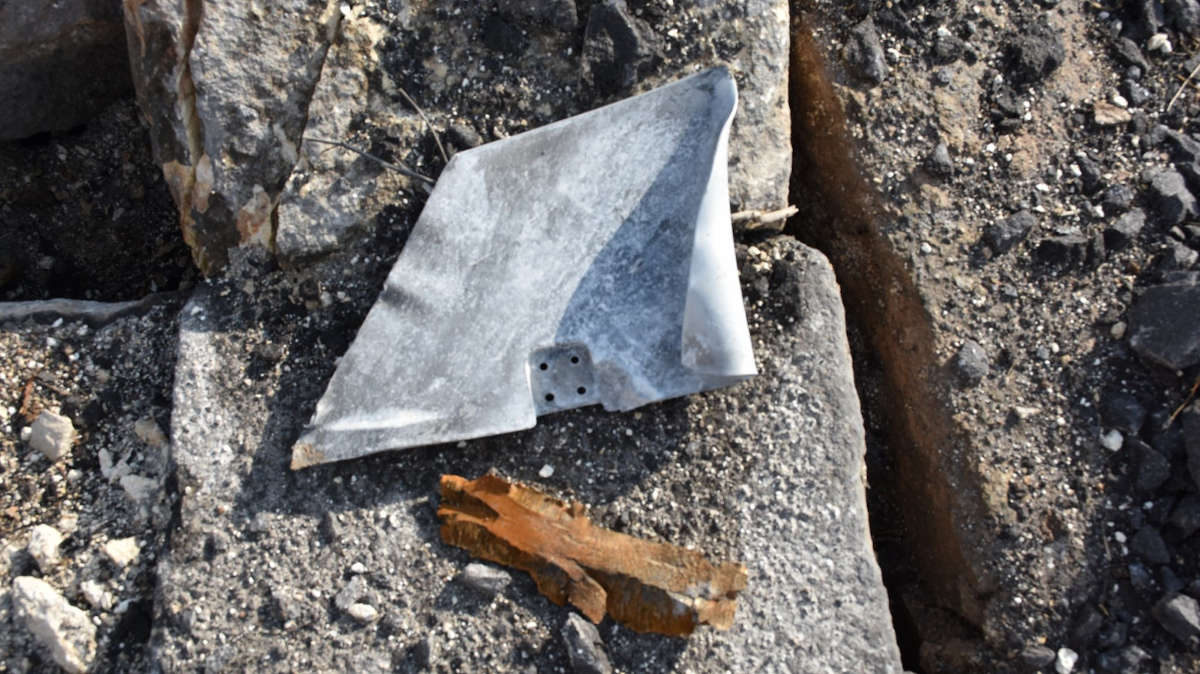

SPECIAL REPORT: CURRENT STATUS OF THE TELL AIN DARA TEMPLE [1]
U. S. DEPT. COOPERATION AGREEMENT NUMBER: S-IZ-100-17-CA021
BY Michael D. Danti, Darren P. Ashby, Marina Gabriel, and Susan Penacho
Initial Release: March 2, 2018
Updated: March 7, 2018
DOWNLOAD: REPORT | قراءة التقرير
* This report is based on research conducted by the “Safeguarding the Heritage of the Near East Initiative,” funded by the US Department of State. Monthly reports reflect reporting from a variety of sources and may contain unverified material. As such, they should be treated as preliminary and subject to change.
Executive Summary
ASOR CHI geospatial analysis indicates that an attack damaged the Ain Dara temple in northwest Syria on or before January 22, 2018. The Ain Dara temple is the best-preserved example of Syro-Hittite religious architecture from the late second and early first millennia BCE. It is elaborately decorated with basalt sculpture and reliefs. Larger-than-life human footprints carved into the temple’s stone thresholds are unique to the building. It is also considered to be a close parallel to the contemporary Temple of Solomon, which is known from descriptions in the Hebrew Bible.
The attack left two craters in the temple—one in the entrance to the building and the other in the entrance to the cella. Both craters are located where thresholds with carved footprints were situated. Due to their proximity to the explosions, the walls, floors, and decorations in the antecella, entrance portico, and southeastern facade of the building received the heaviest damage.
ASOR CHI analysis demonstrates that widespread attributions of the damage to a Turkish airstrike are credible. The attack likely occurred between January 20, 2018, the beginning of airstrikes in connection with Operation Olive Branch, and January 22, 2018. The presence of two distinct craters indicates the use of multiple weapons in the attack. Analysis of photographs and video stills of metal fragments reportedly found at the site suggests that they come from Joint Direct Attack Munitions (JDAMs), probably two GBU-38s. These are present in the arsenal of the Turkish Armed Forces and can be carried by the F-16C/D, a mainstay of the Turkish Air Force. The JDAM is a precision weapon that relies on GPS guidance. This suggests that the area of the temple was targeted deliberately. ASOR CHI is currently unable to determine whether the temple itself or someone/something in the area of the temple was the intended target.
Site Description
Tell Ain Dara is a multi-period archaeological site located in northwest Syria along the east bank of the Afrin River. The site consists of a 30 m-high main mound with an extensive lower mound to the north and east.[2] Occupation at the site divides into two main phases.[3] The earliest excavated remains date from the late second to early first millennium BCE, but occupation at the site began much earlier. This first phase of settlement lasted until ca. the first century BCE. After a period of abandonment lasting roughly 600 years, a second phase of occupation occurred from the 7th–14th centuries CE. Occupation on the lower mound parallels much of the sequence on the upper mound. However, by 600 CE no significant occupation remained in this area.[4]
The historical name of Ain Dara remains unknown. The settlement was likely the capital of one a number of small kingdoms that arose in the region following the disintegration of the Hittite Empire at the end of the second millennium. During the early first millennium, the settlement was controlled by the Aramaean state of Bit Agusi.[5] The region was incorporated into the Neo-Assyrian Empire during the second half of the eighth century BCE.
The most significant find at Tell Ain Dara is the remains of an Early Iron Age (ca. 1200–550 BCE) in antis temple.[6]This structure is the best-preserved example of a temple from this region during this time period. Located along the northwestern edge of the high mound, the northwest-southeast oriented temple rests on a low platform and is decorated with a series of basalt reliefs and animal protomes (an adornment consisting of the frontal view of the creature) carved in the highly distinctive Syro-Hittite style. The core of the temple consists of a portico, an antecella, and a cella. In addition, a passageway runs around the western, northern, and eastern faces of the central series of rooms. A series of limestone thresholds in the temple’s main doorways are adorned with carvings of larger-than-life human footprints that lead inward, conveying the idea that a deity has entered the temple. The presence of these impressions is unique to this building.
The precise dates of the temple’s construction and use remain unknown. The temple was likely founded towards the end of the second millennium and underwent a series of changes before its destruction, possibly in the 8th century BCE.[7] According to the excavator, the building was cleared of rubble in preparation for its reconstruction, but this never materialized. The building was eventually covered and built over in the following centuries.
The god or goddess worshipped in the building remains unknown. The excavator attributed it to Ishtar on the basis of a stele depicting that goddess that was found in a secondary context.[8] Scholars have also offered other suggestions, including the weather god Ba’al Hadad.[9]
Since its discovery, the Ain Dara temple has played a central role in discussions about the appearance of the contemporary Temple of Solomon, which is described in the Old Testament. Some scholars view it as a close parallel.[10] Others are less certain.[11]
Overview of the Incident
On January 23, 2018 the Dutch broadcaster Nederlandse Omroep Stichting (NOS) reported that a Turkish airstrike had damaged the Ain Dara temple.[12] The report, which was based on a conversation with a resident in Afrin District, did not specify the extent of the damage.
On January 27, 2018 Hawar News, an online Kurdish news service based in al-Hasakah, Syria, published a report with photographs and video that showed the temple’s condition.[13] The report attributed the damage to a Turkish airstrike. Photographs and video stills from the Hawar News report quickly spread on social media. Shortly thereafter, other in-country news sources followed with their own coverage of the damage.[14] The reporting led the Turkish Armed Forces to issue a press release in which it asserted that it does not target religious, cultural, historical, or archaeological structures.[15]
ASOR CHI analysis of DigitalGlobe imagery confirms that an attack on the Ain Dara temple occurred on or before January 22, 2018 and that no additional damage to the site occurred in the following days. This correlates with the report in NOS, which was published the following day. The damage to the temple is the only identifiable combat damage at the site.
ASOR CHI’s geospatial analysis has also identified possible militarization at the site over the last few years. Between 2013 and 2016, the eastern area of the low mound was cleared of vegetation and a sand or gravel rectangular area was spread on the ground. Earthen embankments were built up around the area and up onto the northern slope of the high mound. New construction is also visible in the southeastern corner of the low mound as well as off-site to the west of the high mound. In an image from November 9, 2017, new construction has continued, including a structure built into the ground just east of the low mound. A roadblock was also erected on the main road running between the high mound and the eastern low mound. In an image from January 29, 2018, the road block is still in place, while the new construction on the east has been covered in soil with just the entrance to the underground building visible. None of this possible militarization is in the immediate vicinity of the temple. The closest element is the embankment on the northern slope of the high mound, which is roughly 40 m away.
Detailed Review of the Damage to the Building
The attack left two craters in the temple—one in the entrance to the building and the other in the entrance to the cella. Both craters project down deep below the level of the temple’s pavement. The blasts created a linear debris field that extends southeast across the antecella and out through the entrance portico of the building. The orientation of the debris field and the minimal damage evident in the temple’s cella indicate that the attack originated from the northwest.
The explosions heavily damaged the central and southeastern portions of the temple. The majority of the damage occurred in the interior of the temple, but portions of the entrance portico and southeastern facade have also been severely impacted. The exterior walls on the west, north, and east appear to be largely undamaged as does the northern half of the temple. However, these areas are poorly documented in the currently available photographs and video.
Damage to the temple can be grouped into three general areas:
1. The northwestern end of the antecella
2. The entrance portico
3. The southeastern facade of the building
The explosion in the doorway to the cella badly damaged the remains in the northwestern end of the antecella. The blast destroyed most of the stone threshold in the doorway. This threshold had a carved impression of a human right foot. Partially-preserved door jambs with carvings of lions have also been severely damaged. Further, the sculpture and reliefs on either side of the doorway between the antecella and cella have been reduced to rubble. The force of the blast has also scattered the basalt steps that lead up to the doorway into the cella as well as dislodged portions of the limestone paving in the antecella.
The blast in the entrance portico also caused extensive damage. The explosion occurred directly on top of the two stone thresholds with carved human footprints in the entrance to the building, which disintegrated them. The basalt decorations, including the column bases on either side of the doorway, have also been uprooted and fragmented.
The explosion in the entrance portico also affected the decorations on the southeastern facade of the temple. To the west of the portico, three out of five large lion sculptures collapsed towards the southeast. The fragments of these fell onto a pair of smaller lion and sphinx reliefs along the base of the temple, breaking them into pieces as well.
The remains of the basalt stairs in front of the portico were also affected. The blast dislodged both the single step at the western end of the portico and the four steps at its eastern end. Though covered in rubble, the constituent parts of the stairs appear to be largely intact.
Finally, the reliefs east of the portico have been damaged as well. A pair of reliefs—one sphinx, one lion—immediately east of the stairs have been broken in half and partially dislodged.
Analysis and Discussion of Claims of Turkish Responsibility
Reporting on the damage to the Ain Dara temple has largely attributed the attack to the Turkish Air Force. ASOR CHI has analyzed the damage to the site as well as photographs and video of the fragments of metal reportedly found in the temple in order to test the validity of this attribution.
Geospatial analysis has established that the attack occurred on or before January 22, 2018. This indicates the possibility that it occurred during the first days of the Turkish operation in Afrin District, which began on January 20, 2018. The damage to the temple is the only evidence of combat damage or airstrikes at the site or in its immediate vicinity that is visible in satellite imagery. ASOR CHI is currently unable to confirm the reported existence of two additional craters present in unexcavated areas of the site, nor is it clear if these two craters are comparable to those in the temple.[16]
The presence of two craters indicates that multiple weapons were used in the attack. Hawar News published photographs of metal fragments purportedly recovered at the site. Video evidence demonstrates that one of these fragments was moved to another location, probably for photographic purposes.
Two of the fragments bear a close resemblance to the tail fin present on the Joint Direct Attack Munition (JDAM).[17] The JDAM is a GPS-guided weapon.[18] It consists of an unguided bomb equipped with a tail control system and an internal guidance system that make the weapon “smart.” The weapon has a 5 m-radius of accuracy when using GPS and a 30 m-radius when GPS is unavailable, provided certain conditions. Although Boeing is the primary producer of this conversion kit, Tübitak Sage, a Turkish company, also manufactures its own version of the technology.[19] The Turkish Air Force has the JDAM in its arsenal. Turkish F-16C/Ds are equipped to carry the weapon.
The JDAM comes in multiple sizes:
1. GBU-31 (a Mk 84 2000 lb bomb body)
2. GBU-32 (a Mk 83 1000 lb bomb body)
3. GBU-38 (a Mk 82 500 lb bomb body)
If a JDAM caused the damage at the temple, the scale of the damage suggests that a GBU-38, the smallest variety, was used in the attack.
To conclude, attributions of the damage to a Turkish airstrike(s) are credible. The strike(s) would have occurred between January 20 and January 22, 2018. Evidence from the site suggests that the attack was conducted by a Turkish F-16C/D using a JDAM, possibly a GBU-38. The JDAM is a precision weapon, which raises the possibility that the area of the temple was targeted deliberately. This possibility is reinforced by the location of the two strike in the middle of the temple where there were unique, famous monumental footprints carved into the floor slabs. No evidence is currently available to discern whether the temple itself or someone/something in the immediate area of the temple was the intended target.
Bibliography
Abu Assaf, Ali (1990) Der Tempel von ‘Ain Dārā. Damaszener Forschungen, vol. 3. Mainz am Rhein: Philipp von Zabern.
Abu Assaf, Ali (1996) “Die Kleinfunde aus ‘Ain Dārā” Damaszener Mitteilungen 9: 47–111.
Abu Assaf, Ali (Undated) The Temple of ‘Ain Dara. Syrian Site Tourism Pamphlet.
Akkermans, Peter M. M. G. and Glenn M. Schwartz (2003) The Archaeology of Syria. From Complex Hunter-Gatherers to Early Urban Societies (ca. 16,000–300 BC). Cambridge: Cambridge University Press.
Ghassan Shami: https://www.facebook.com/ghassanshami/videos/10157472502163438/
Hawar News (ANHA): http://www.hawarnews.com/ﻃﺎﺋﺮات-اﻻﺣﺘﻼل-اﻟﺘﺮﻛﻲ-دﻣﺮ-ﺗﻞ-ﻋﯿﻦ-دارة/
The Authority of Tourism and Protection of Antiquities – Jazira Canton (ATPA): http://desteya-shunwaran.com/ar/the-damage-in-ain-dara-temple/
Global Security: https://www.globalsecurity.org/military/systems/munitions/gbu-38.htm
Hurowitz, Victor (2011) “Solomon’s Temple in Context,” Biblical Archaeology Review 37, no. 2: 46–57
Monson, John (2000) “The New ‘Ain Dara Temple: Closest Solomonic Parallel.” Biblical Archaeology Review 26, no. 3: 20–24, 27–30, 33–35.
Monson, John (2006) “The ‘Ain Dara Temple and the Jerusalem Temple,” in Text, Artifact, and Image: Revealing Ancient Israelite Religion G. Beckman, T. J. Lewis (eds.). Providence: Brown Judaic Studies, 273–299.
Nederlandse Omroep Stichting: https://nos.nl/artikel/2213464-burgers-in-afrin-over-turkse-bombardementen-niemand-kijkt-naar-ons-om.html
Syrian Arab News Agency:
January 28, 2018: https://sana.sy/en/?p=125653
January 29, 2018: https://sana.sy/en/?p=125702
Stager, Lawrence E. (2000) “Jerusalem as Eden,” Biblical Archaeology Review 26, no. 3: 36–39, 41–47.
Syrian Directorate-General of Antiquities and Museums: http://dgam.gov.sy/index.php?d=314&id=2374
Syrian Observatory for Human Rights:
January 28, 2018: https://www.facebook.com/syriahro/videos/10156446658028115/
January 28, 2018: https://www.facebook.com/syriahro/posts/10156446657648115
Tübitak Sage: http://www.sage.tubitak.gov.tr/tr/urunler/hassas-gudum-kiti-hgk
Turkish Armed Forces: http://www.tsk.tr/BasinFaaliyetleri/BA_67
US Air Force: http://www.af.mil/About-Us/Fact-Sheets/Display/Article/104572/joint-direct-attack-munition-gb
u-313238/
Notes
[1]In this report, ASOR CHI has attempted to test the validity of claims made by others concerning the recent damage to the temple at Tell Ain Dara. The conclusions in this report are based upon open-source documentation. ASOR CHI does not have the capacity to verify this documentation nor to confirm attributions of responsibility or postulations about intent present in other reporting about the incident.
[2] Assaf 1990: 1
[3] Assaf 1990: 10
[4] Stone and Zimansky 1999: 139
[5] Akkermans and Schwartz 2003: 370
[6] Assaf 1990
[7] Assaf 1990: 10; Stone and Zimansky 1999: 3
[8] Assaf 1990: 42
[9] Stager 2000: 44
[10] Monson 2000; Stager 2000; Monson 2006
[11] Hurowitz 2011
[12] https://nos.nl/artikel/2213464-burgers-in-afrin-over-turkse-bombardementen-niemand-kijkt-naar-ons-om.html
[13] http://www.hawarnews.com/ﻃﺎﺋﺮات-اﻻﺣﺘﻼل-اﻟﺘﺮﻛﻲ-دﻣﺮ-ﺗﻞ-ﻋﯿﻦ-دارة/
[14] https://www.facebook.com/syriahro/videos/10156446658028115/; https://www.facebook.com/syriahro/posts/10156446657648115; https://sana.sy/en/?p=125653; https://sana.sy/en/?p=125702; http://dgam.gov.sy/index.php?d=314&id=2374
[15] http://www.tsk.tr/BasinFaaliyetleri/BA_67
[16] https://www.facebook.com/ghassanshami/videos/10157472502163438/
[17] Thank you to Christiaan Triebert for his assistance with the initial identification of these fragments.
[18] http://www.af.mil/About-Us/Fact-Sheets/Display/Article/104572/joint-direct-attack-munition-gbu-313238/
[19] http://www.sage.tubitak.gov.tr/tr/urunler/hassas-gudum-kiti-hgk
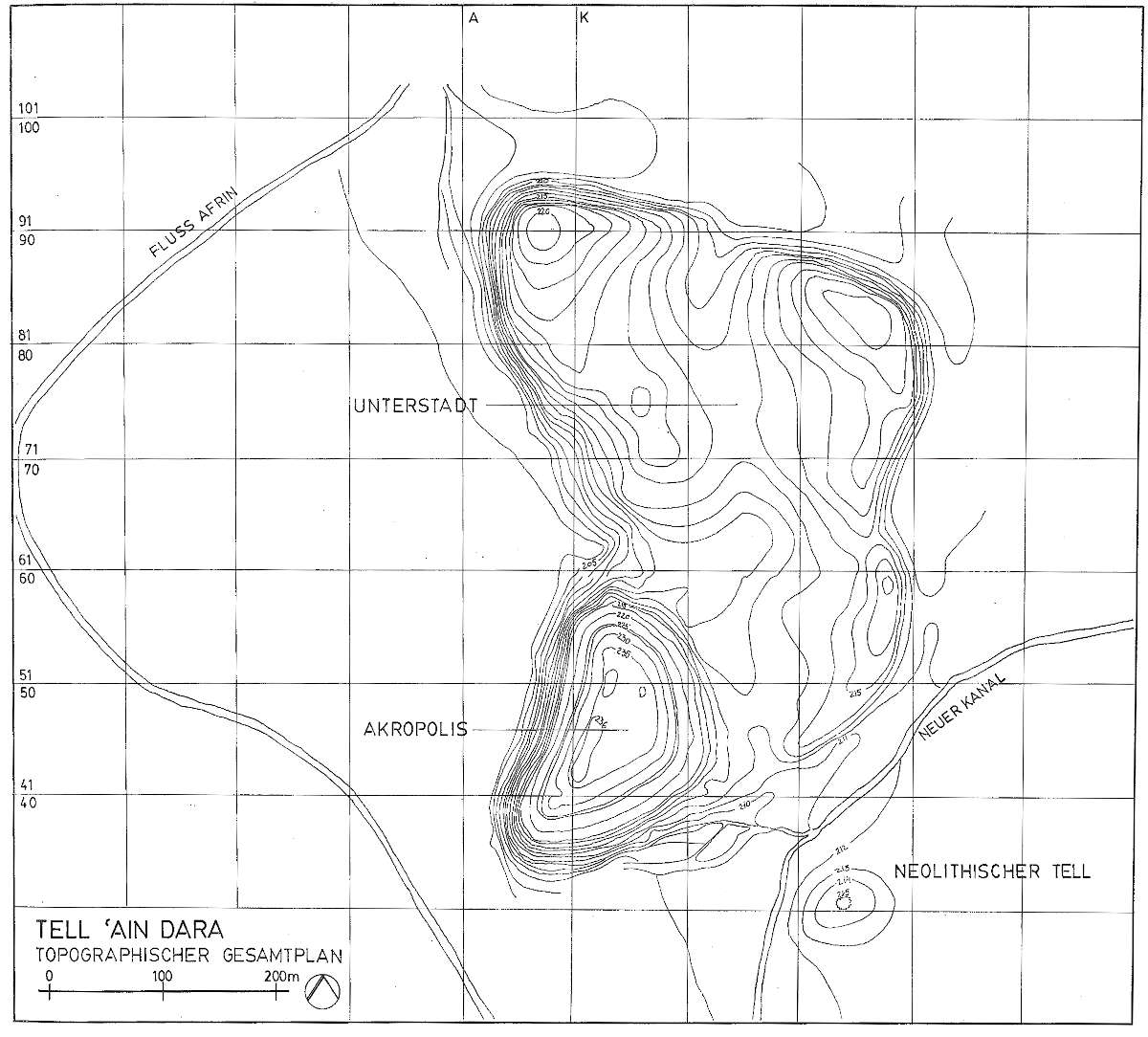
Site Plan of Tell Ain Dara (Assaf 1990: 3, fig. 2)
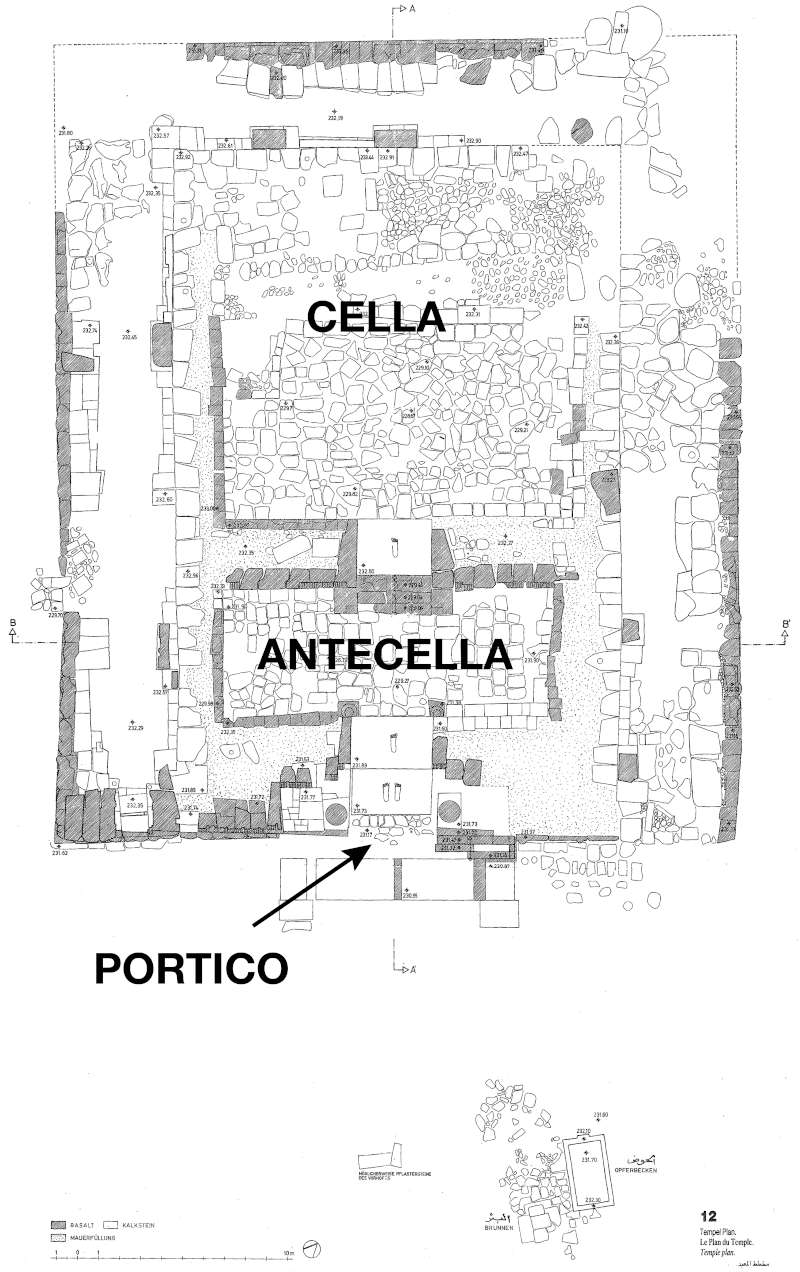
Plan of the Ain Dara temple (Original from Assaf Undated: fig. 12)
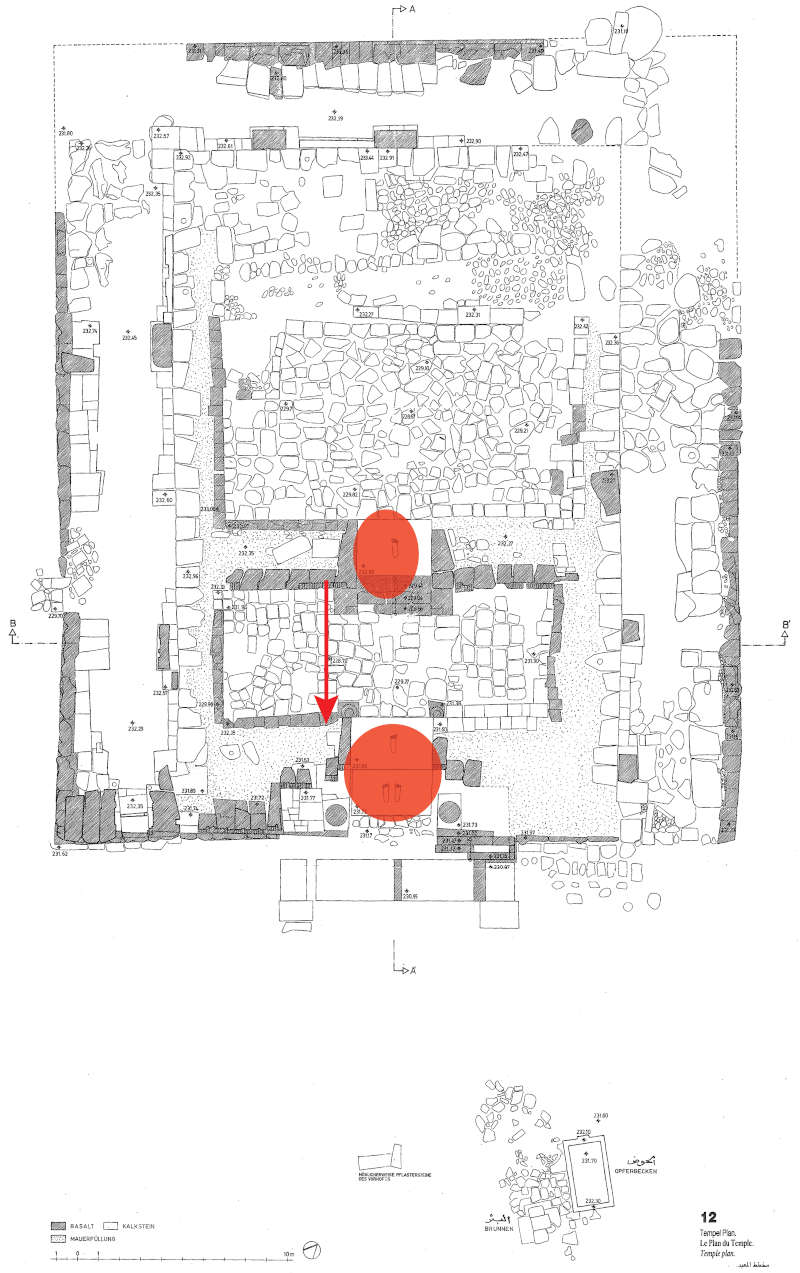
The location of the two craters and the direction of movement of the debris from the northwest to the southeast (Original from Assaf Undated: fig. 12)
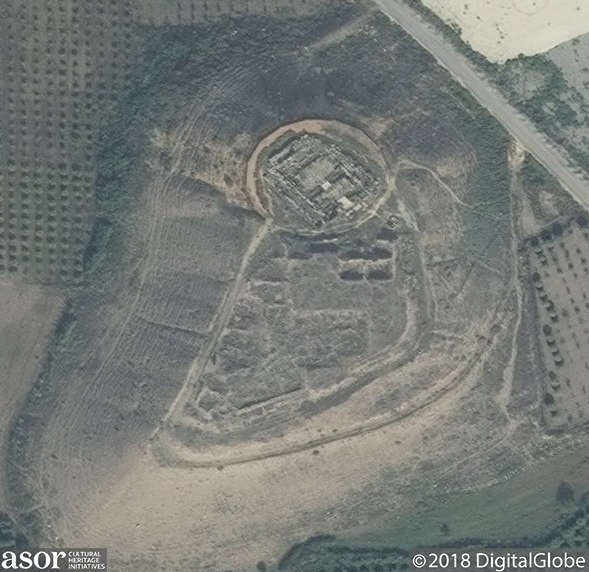
Tell Ain Dara prior to recent military damage (DigitalGlobe NextView License; November 9, 2017)
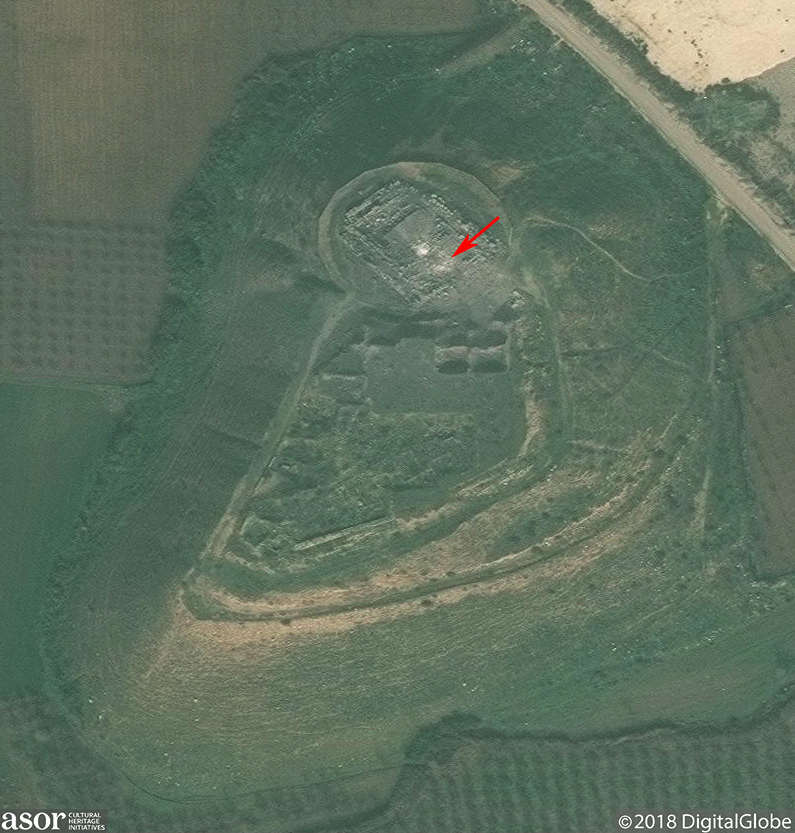
Location of the attack within the Tell Ain Dara temple, indicated by the red arrow (DigitalGlobe NextView License; January 22, 2018)
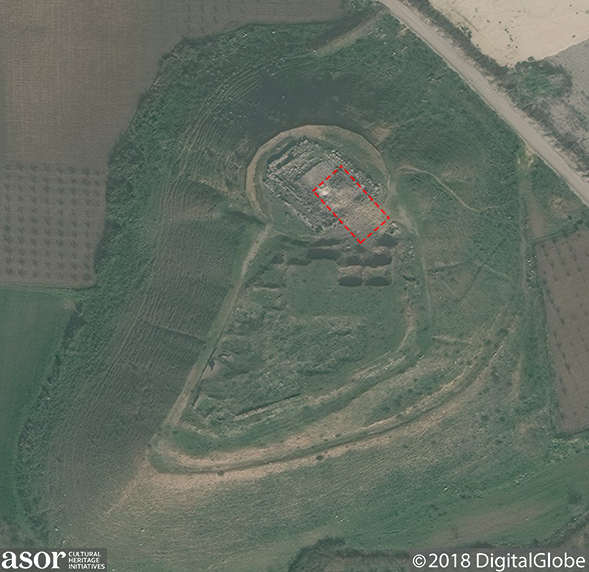
Damage from attack on Tell Ain Dara temple, with debris field indicated by the red box (DigitalGlobe NextView License; January 29, 2018)
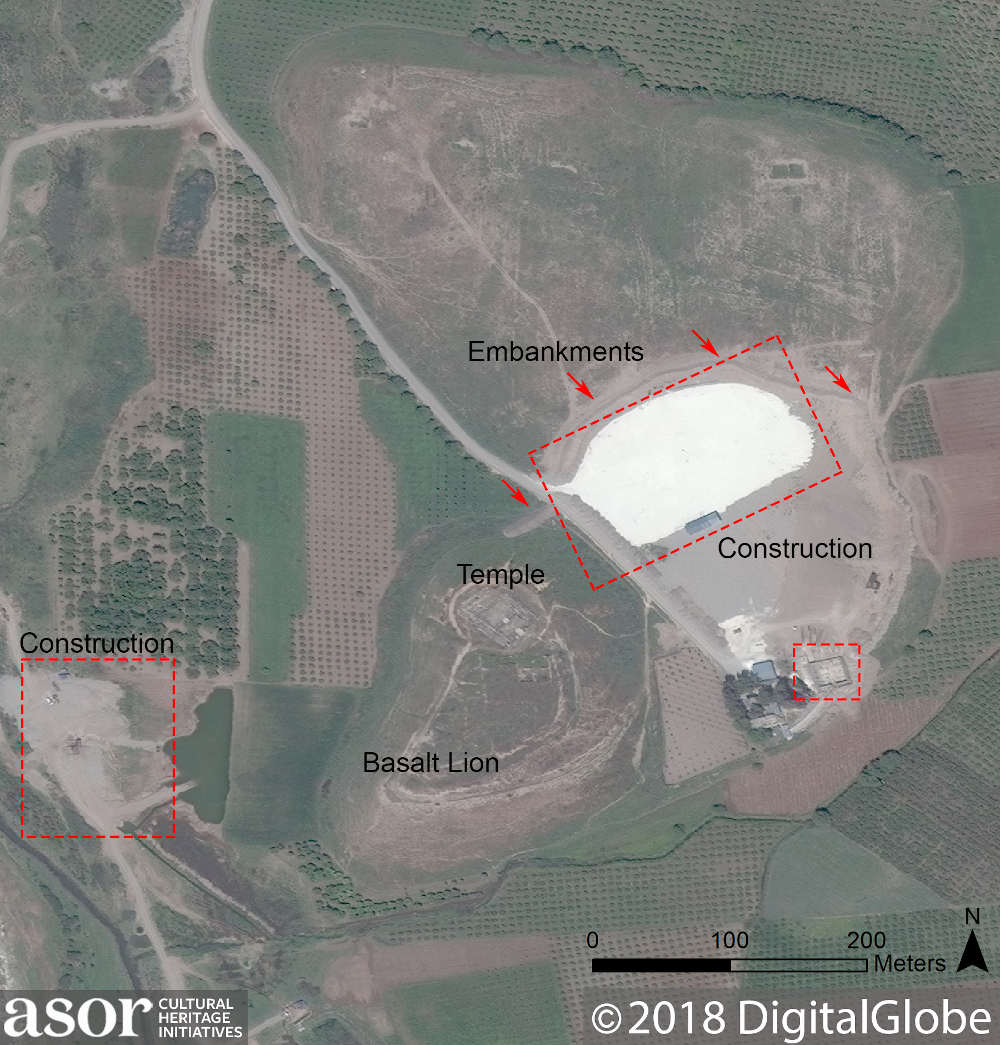
New construction and earthen embankments built on the eastern part of the low mound at Tell Ain Dara (DigitalGlobe NextView License; April 17, 2016)
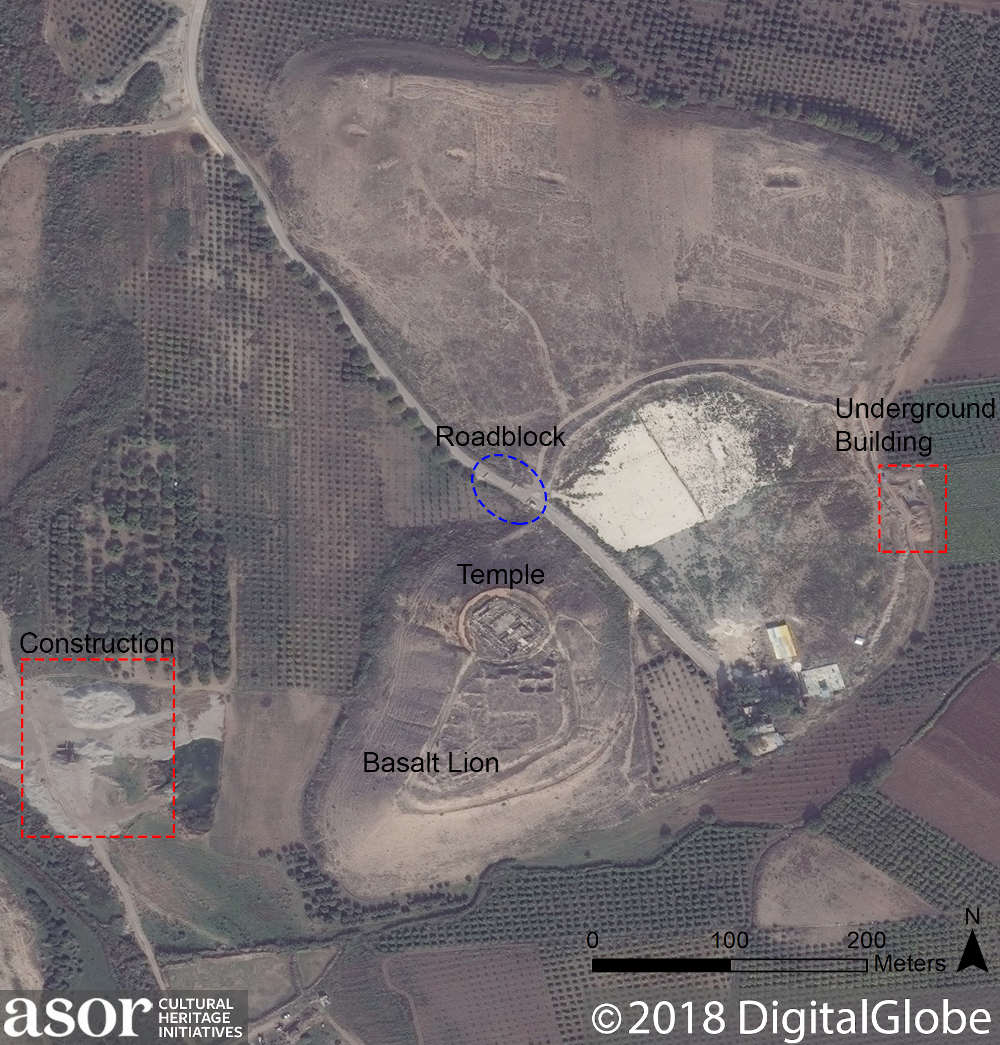
Construction on the eastern side of Tell Ain Dara and a roadblock near the site (DigitalGlobe NextView License; November 9, 2017)
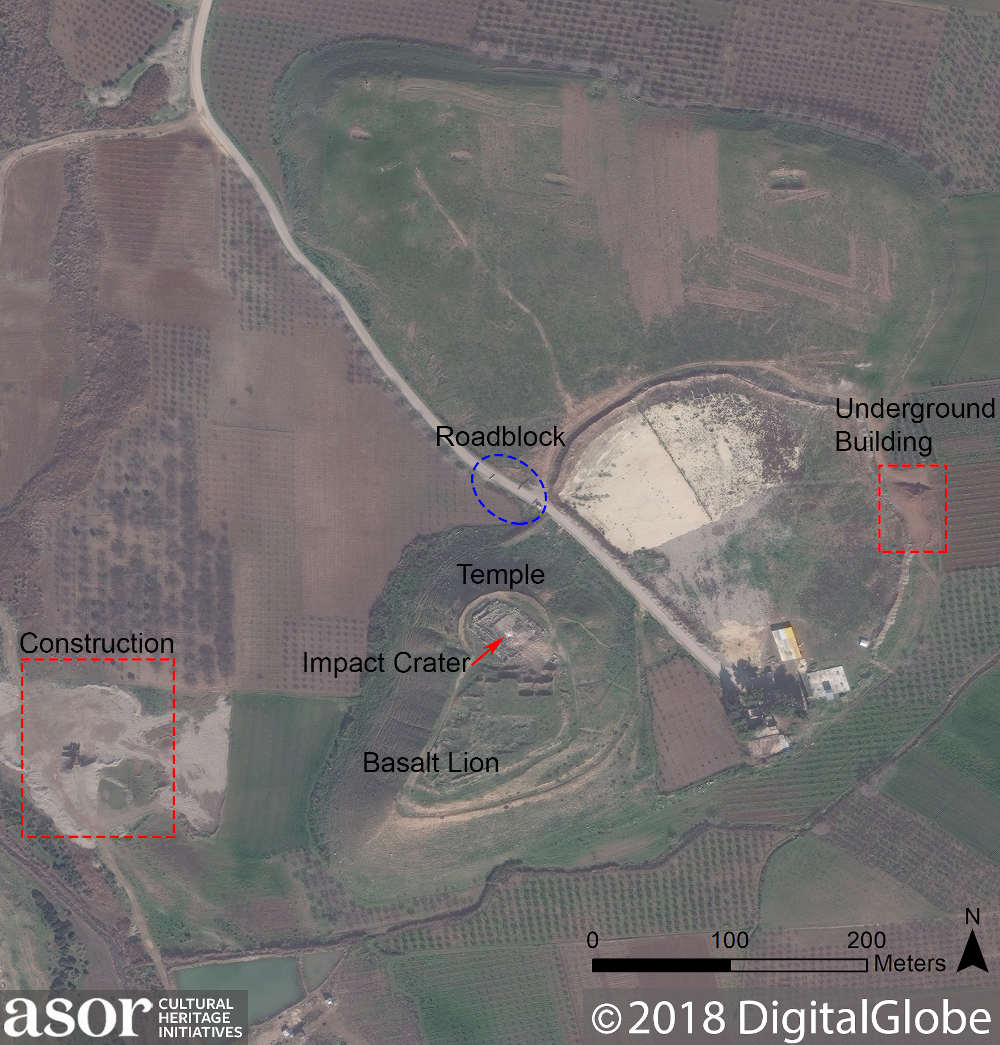
Damage to the Tell Ain Dara temple indicated by a red arrow (DigitalGlobe NextView License; January 29, 2018)
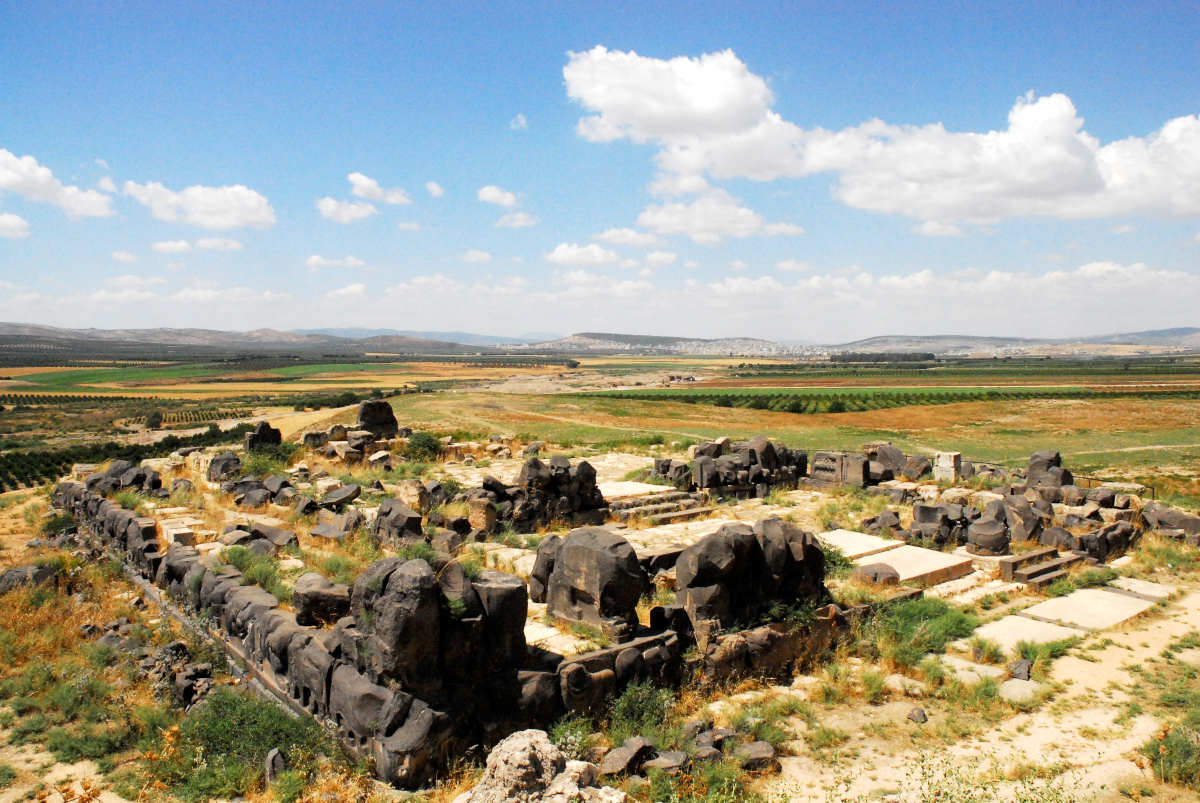
The condition of the Ain Dara temple in 2010 (Michael Danti; June 2010)
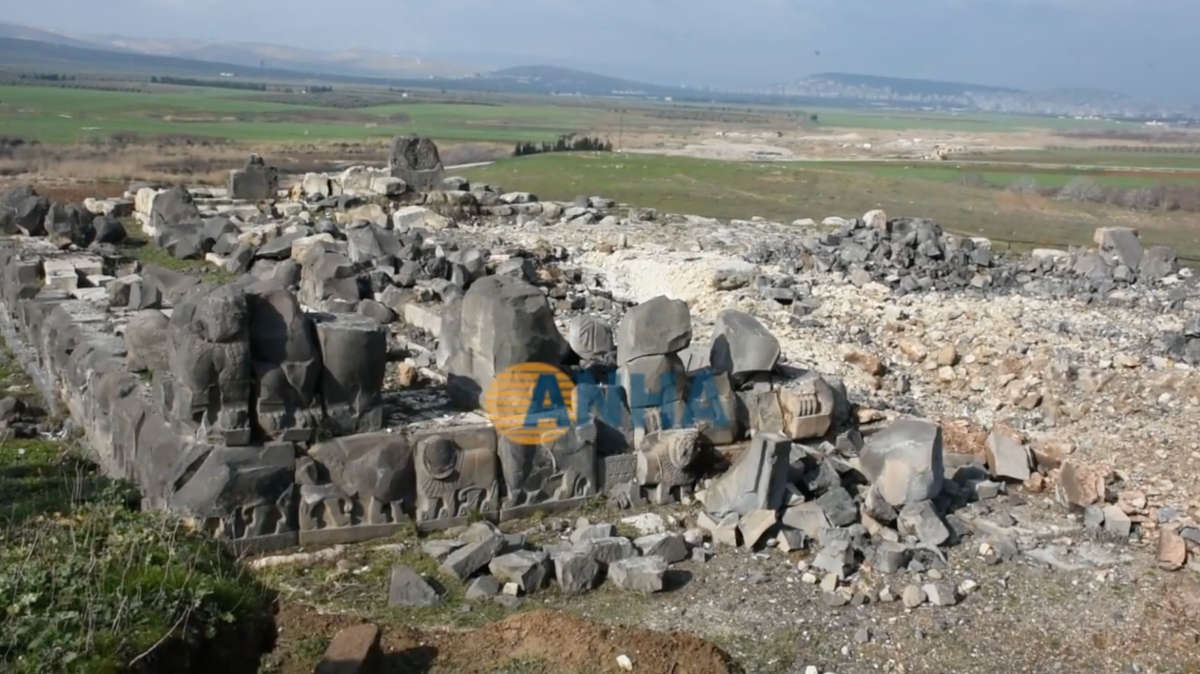
Video still of the temple after the attack (ANHA; January 27, 2018)
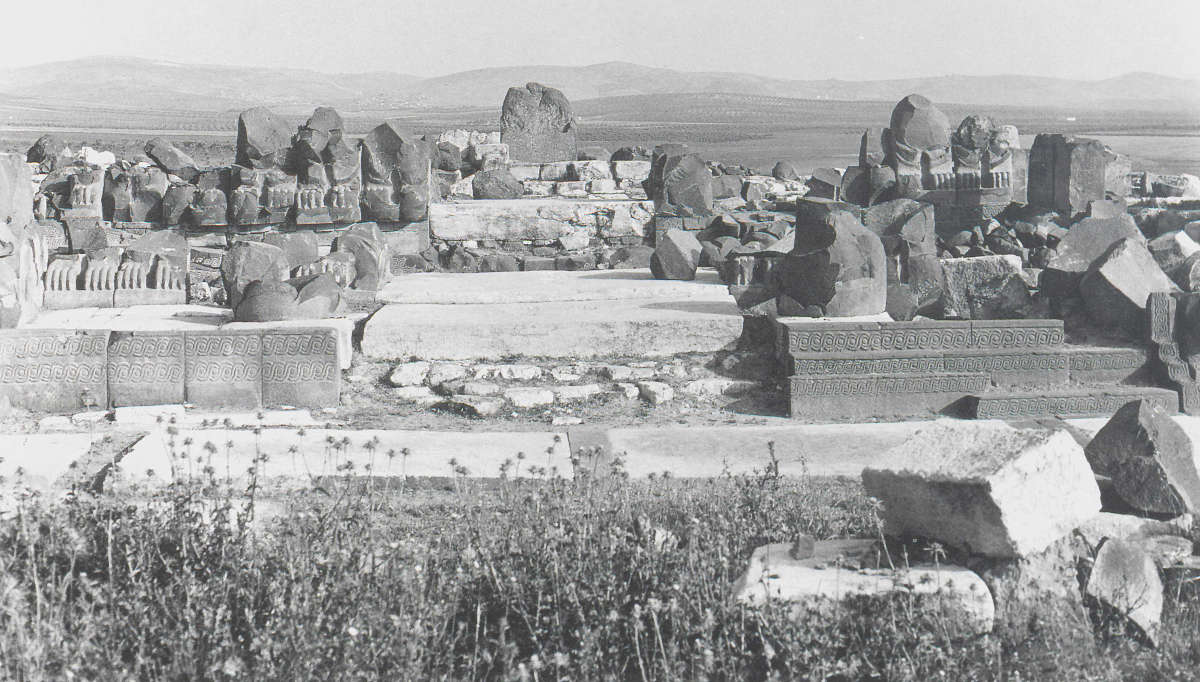
The entrance to the temple at the end of excavation (Assaf 1990: Taf. 9a)
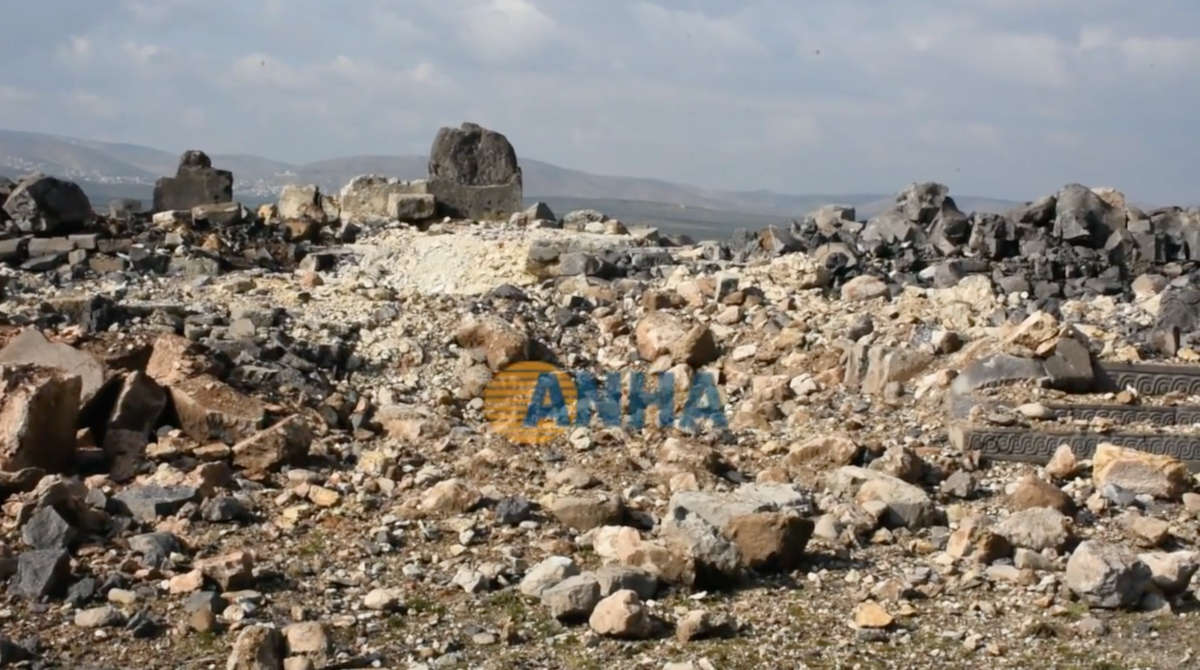
Video still of the entrance to the temple following the attack (ANHA; January 27, 2018)
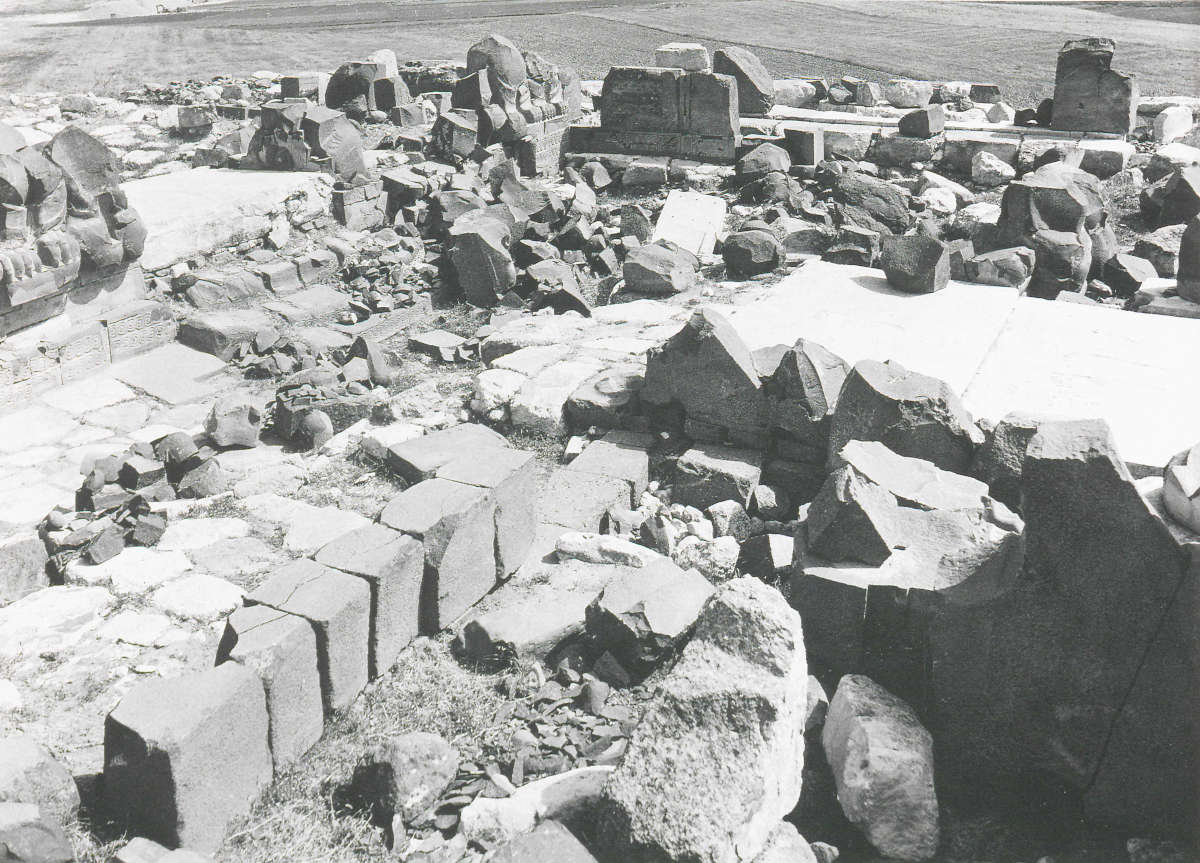
The antecella at the end of excavation, seen from the south (Assaf 1990: Taf. 12a)
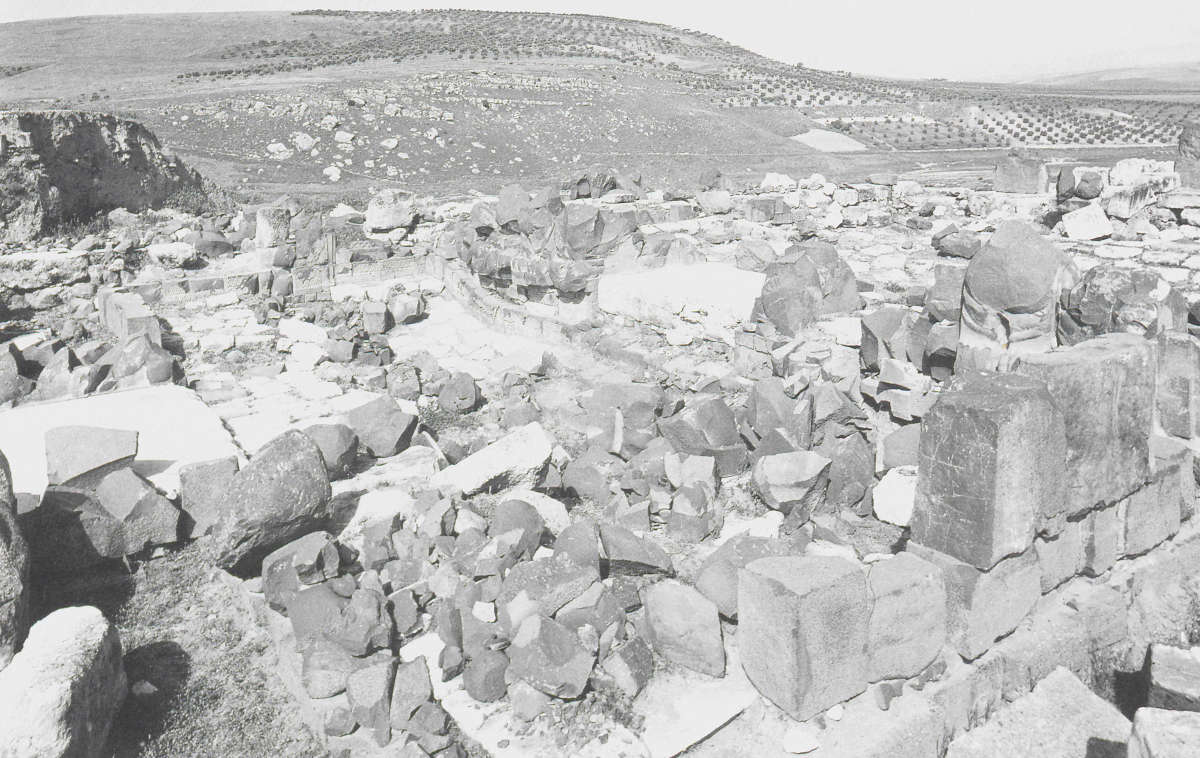
The antecella at the end of excavation, seen from the east (Assaf 1990: Taf. 8b)
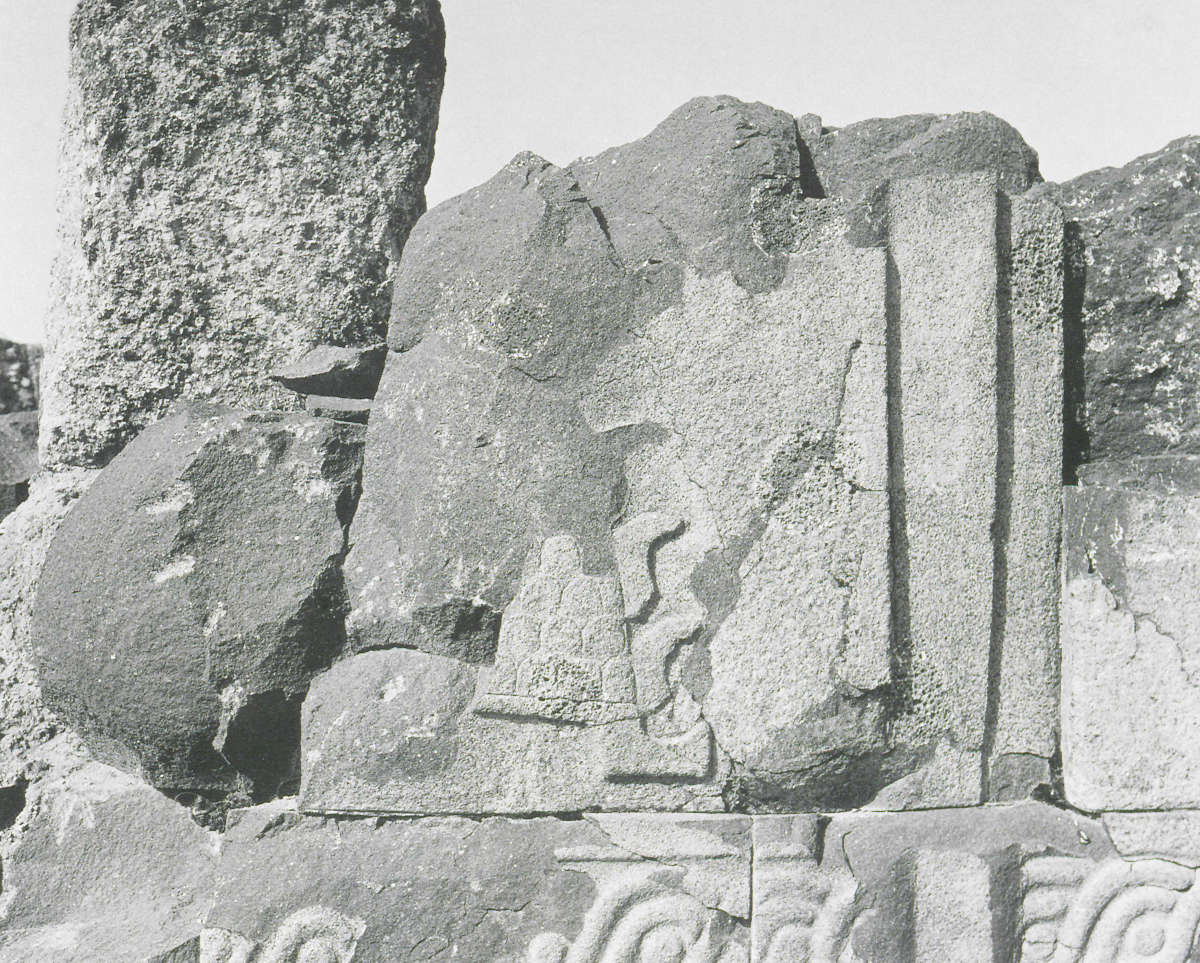
Reliefs along the northern end of the western wall of the antecella at the end of excavation (Assaf 1990: Taf. 41b)
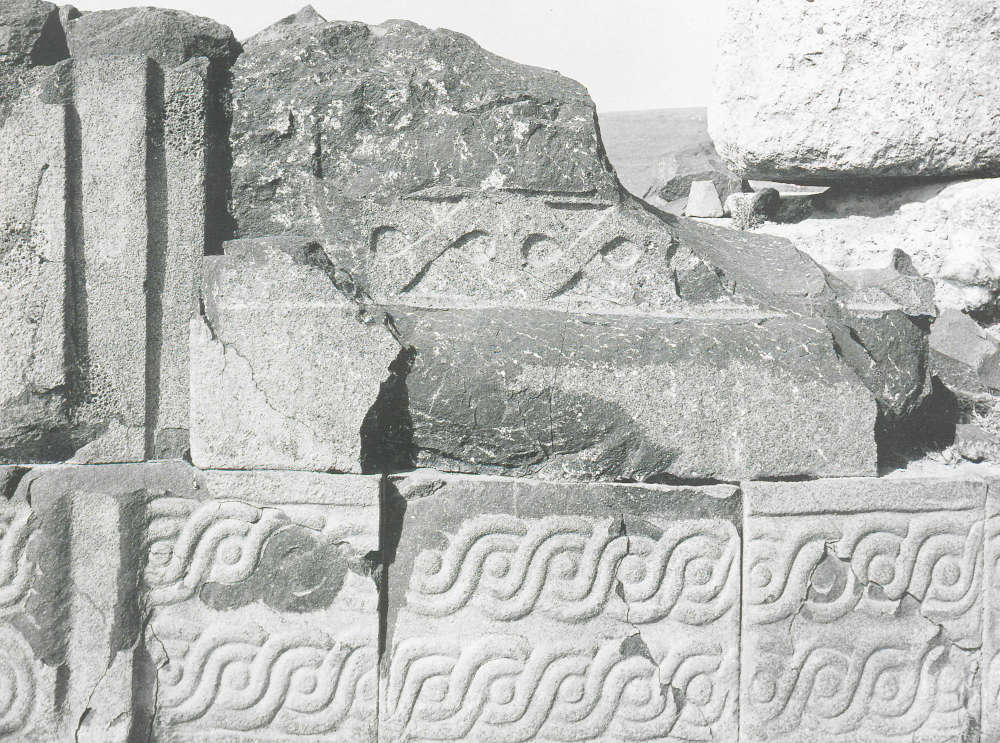
Reliefs along the northern end of the western wall of the antecella at the end of excavation (Assaf 1990: Taf. 42a)
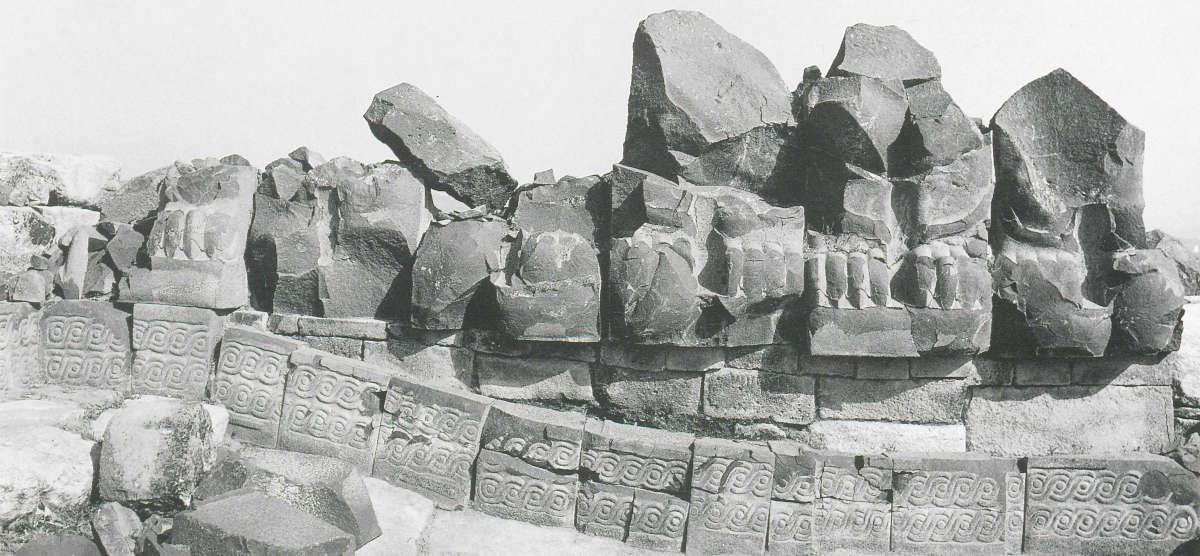
Reliefs and sculpture to the west of the entrance to the cella, seen from the southeast (Assaf 1990: Taf. 40a)
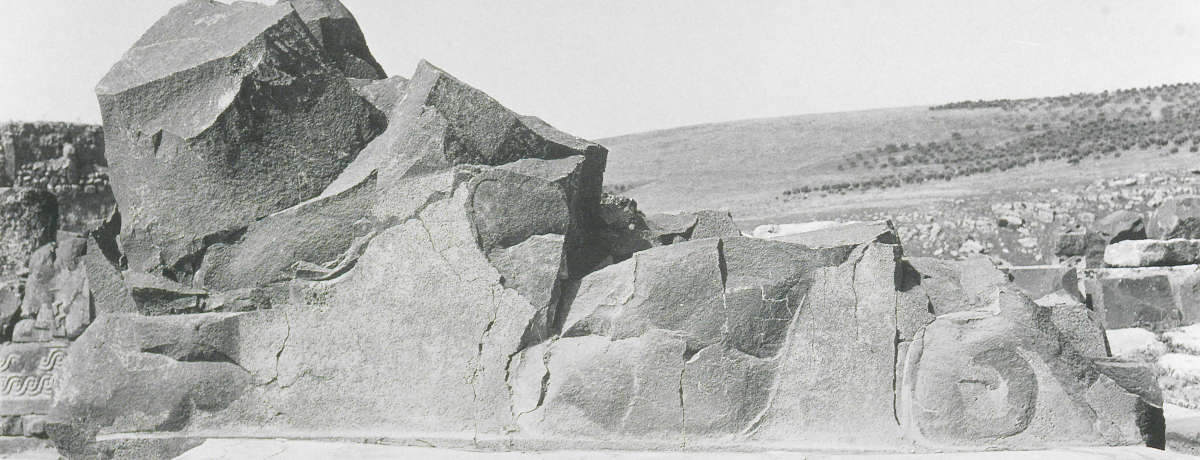
The western jamb of the door to the cella at the end of excavation (Assaf 1990: Taf. 40b)

The eastern jamb of the door to the cella at the end of excavation (Assaf 1990: Taf. 40c)
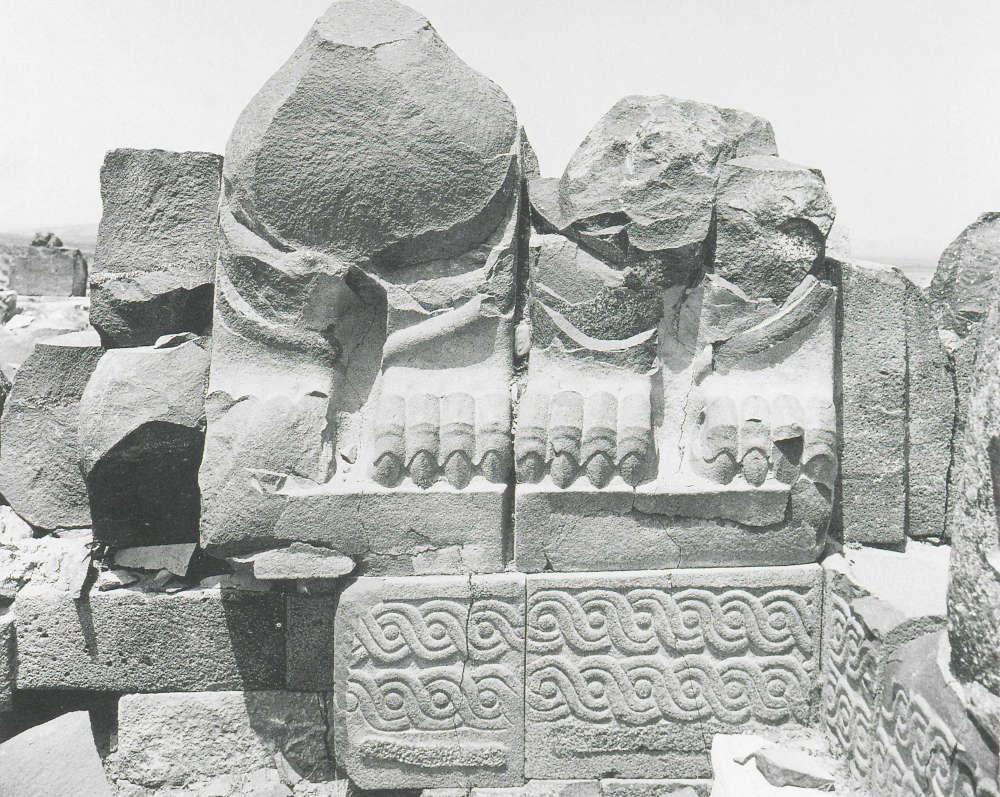
Reliefs and sculpture in the northeastern corner of the antecella at the end of excavation (Assaf 1990: Taf. 41a)
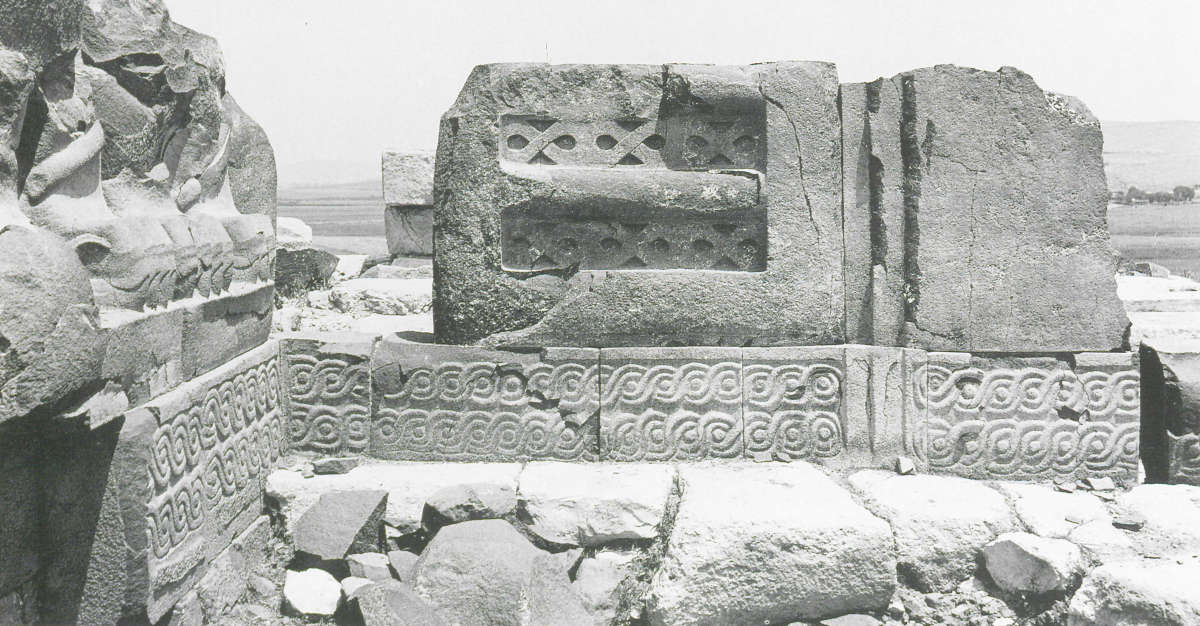
Reliefs and sculpture in the northeastern corner of the antecella at the end of excavation (Assaf 1990: Taf. 42b)
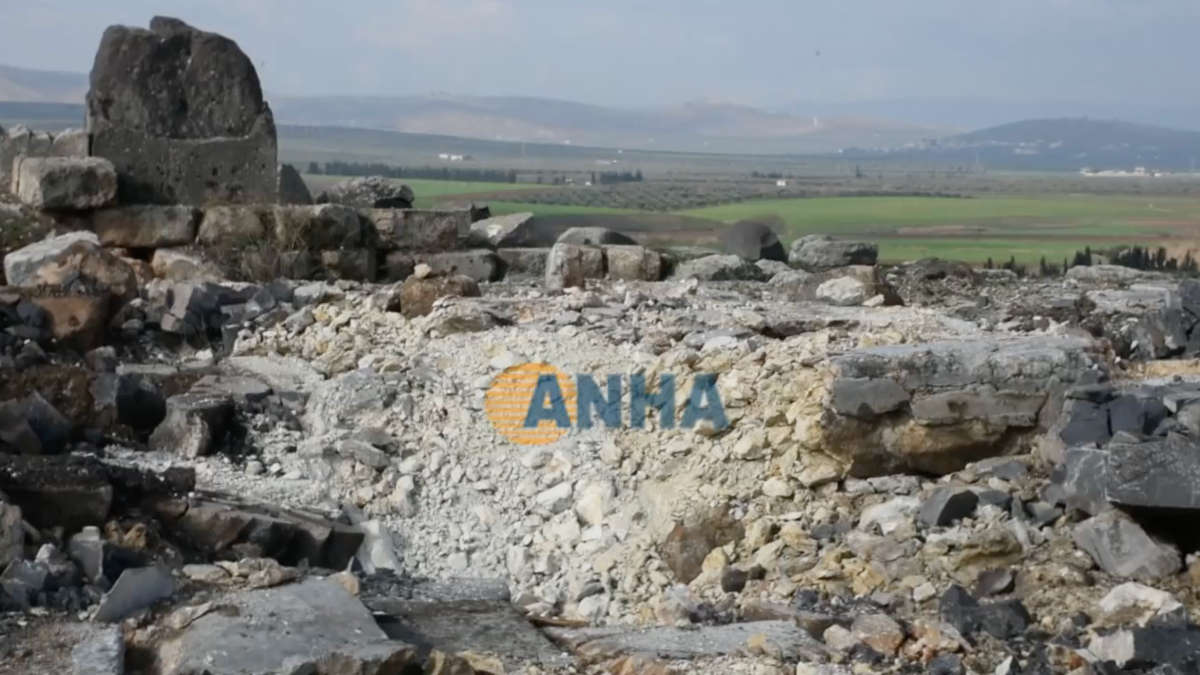
Video still of the crater in the threshold of the doorway to the cella, seen from the southeast (ANHA; January 27, 2018)
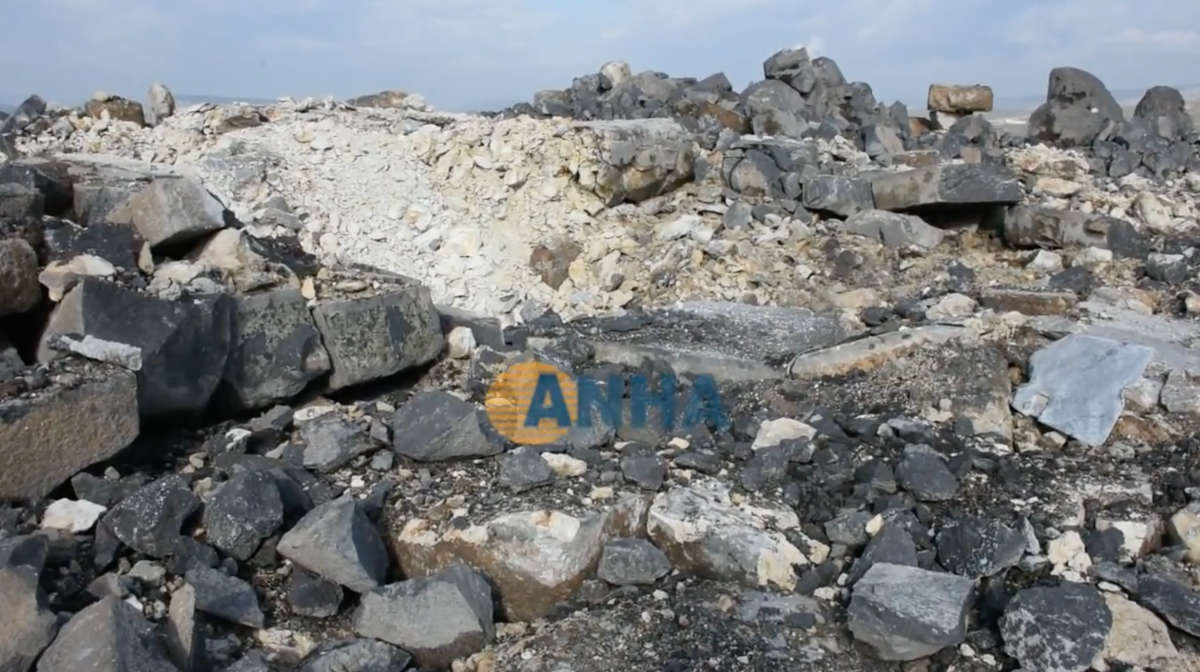
Video still of the crater in the threshold of the doorway to the cella, seen from the south. The remains of the reliefs and sculpture in the northeastern corner of the room are visible in the background (ANHA; January 27, 2018)
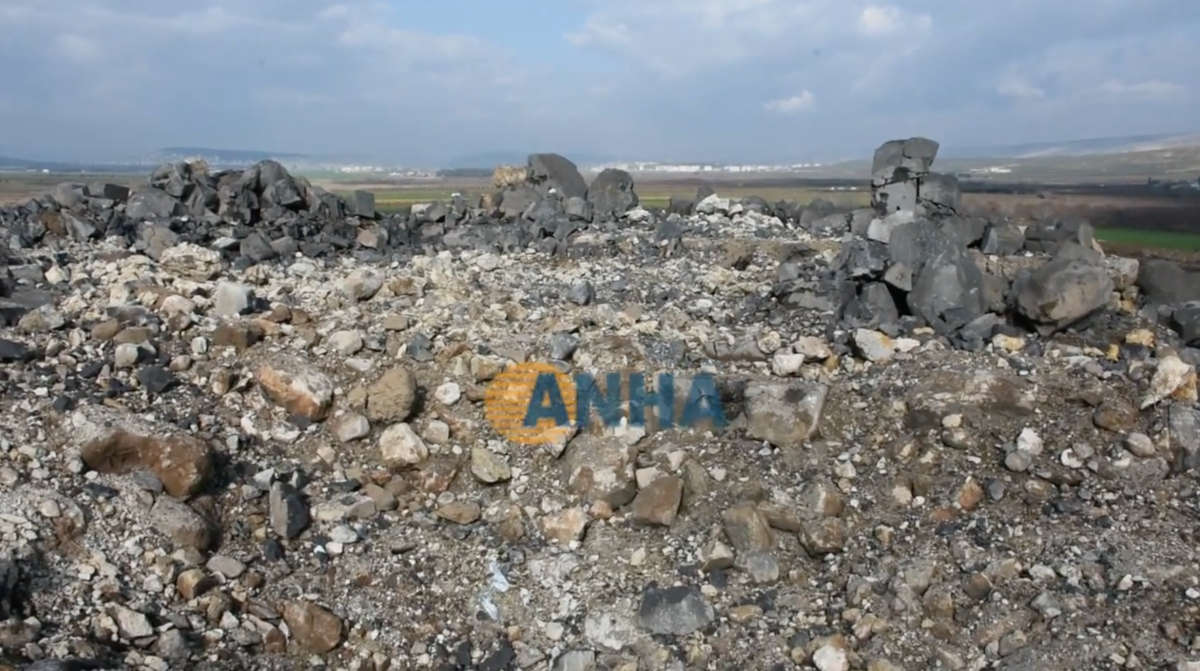
Video still of the antecella, seen from the southwest. The remains of the reliefs and sculpture in the northeastern corner of the room are visible in the upper left corner (ANHA; January 27, 2018)
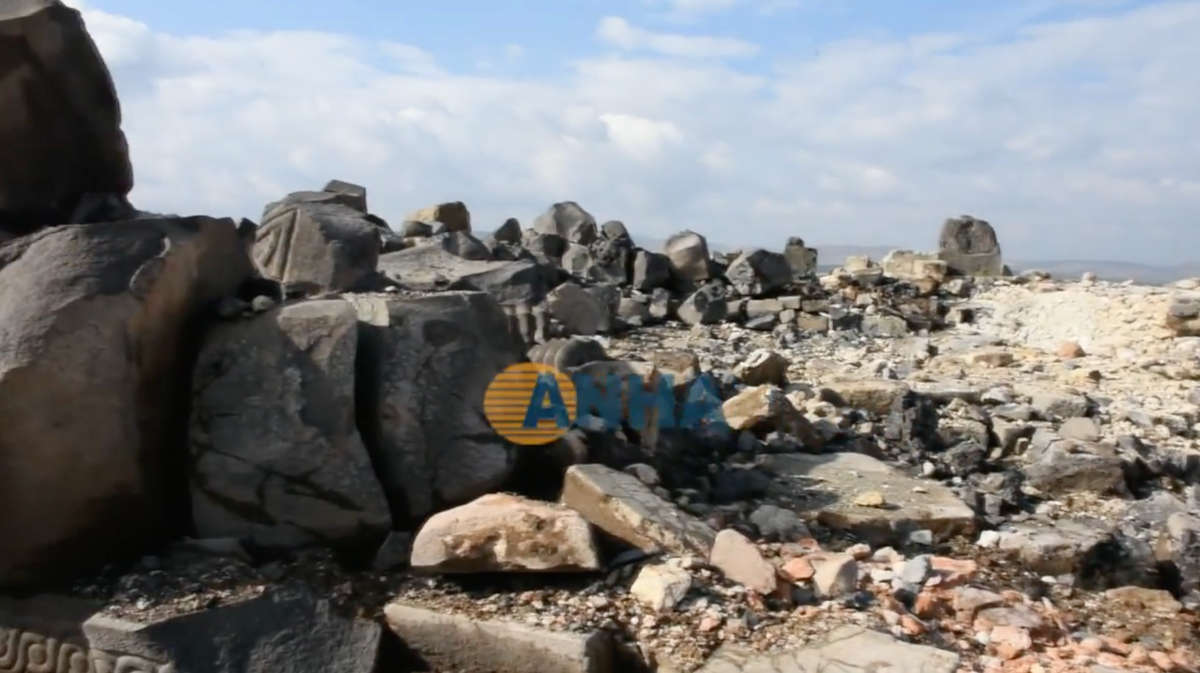
Video still of the western half of the portico and antecella, seen from the southeast. The remains of the reliefs and sculpture in the northwestern corner of the antecella are visible in the background to the left of the crater, which is present along the right edge of the image (ANHA; January 27, 2018)
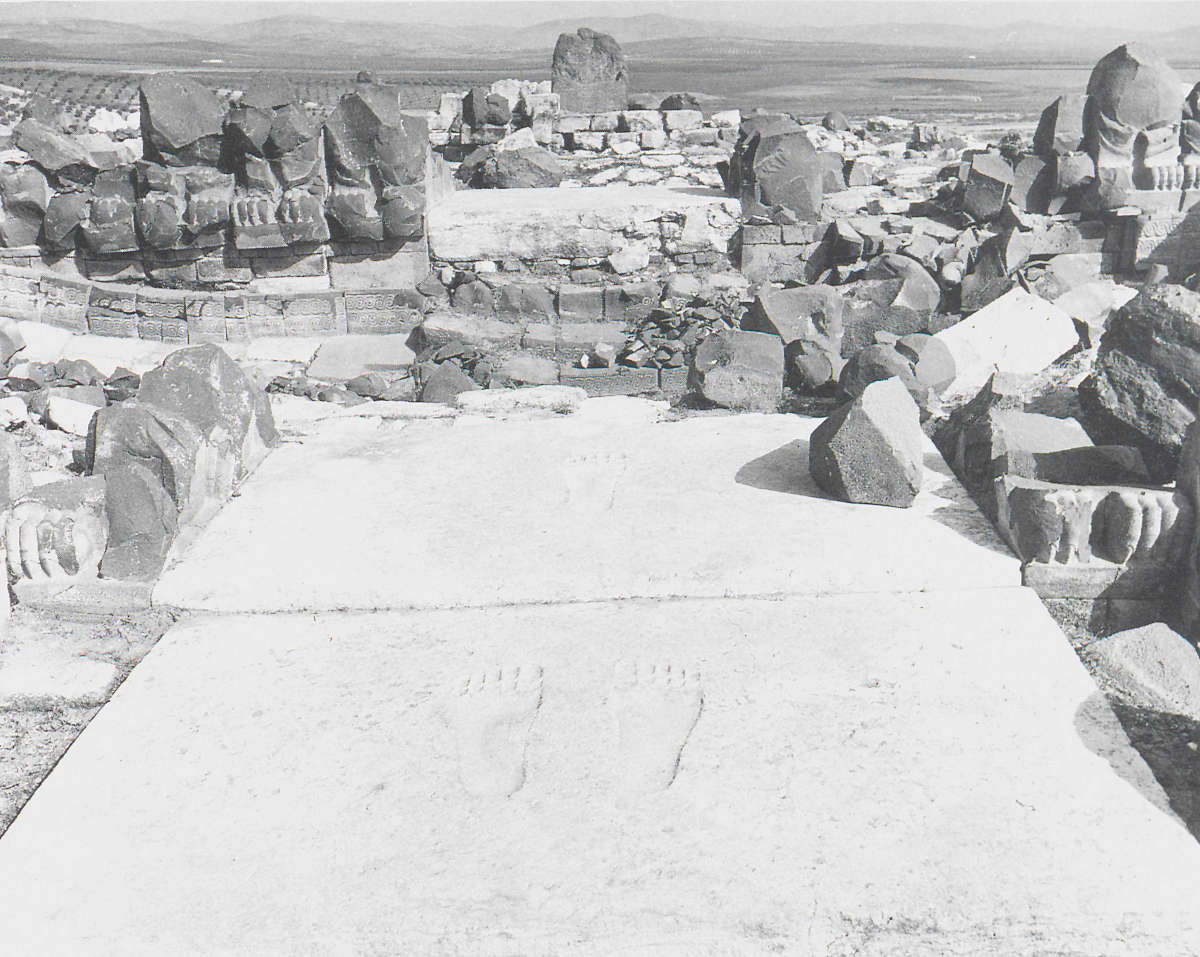
The carved thresholds in the entrance at the end of excavation, seen from the southeast (Assaf 1990: Taf. 11a)
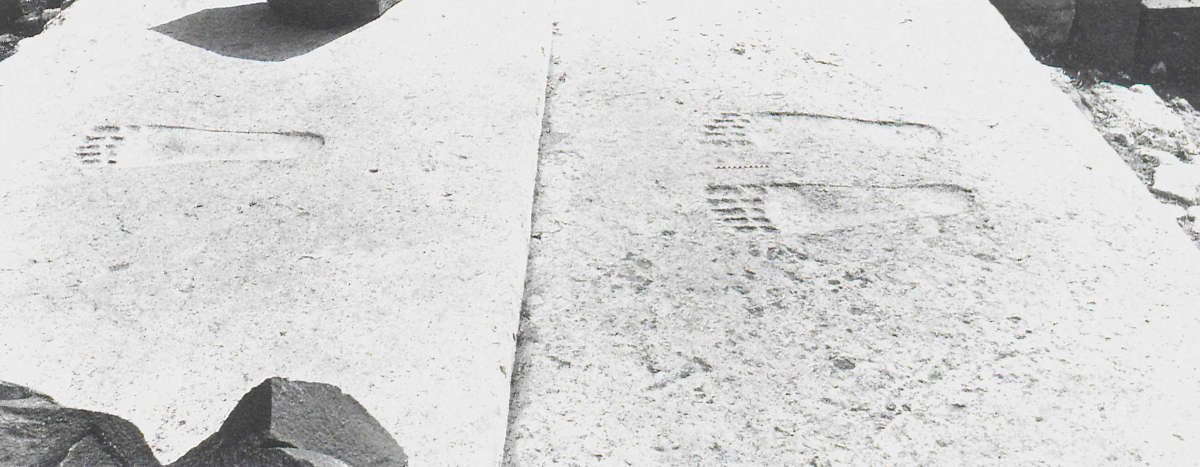
The carved thresholds in the entrance at the end of excavation, seen from the southwest (Assaf 1990: Taf. 11b)
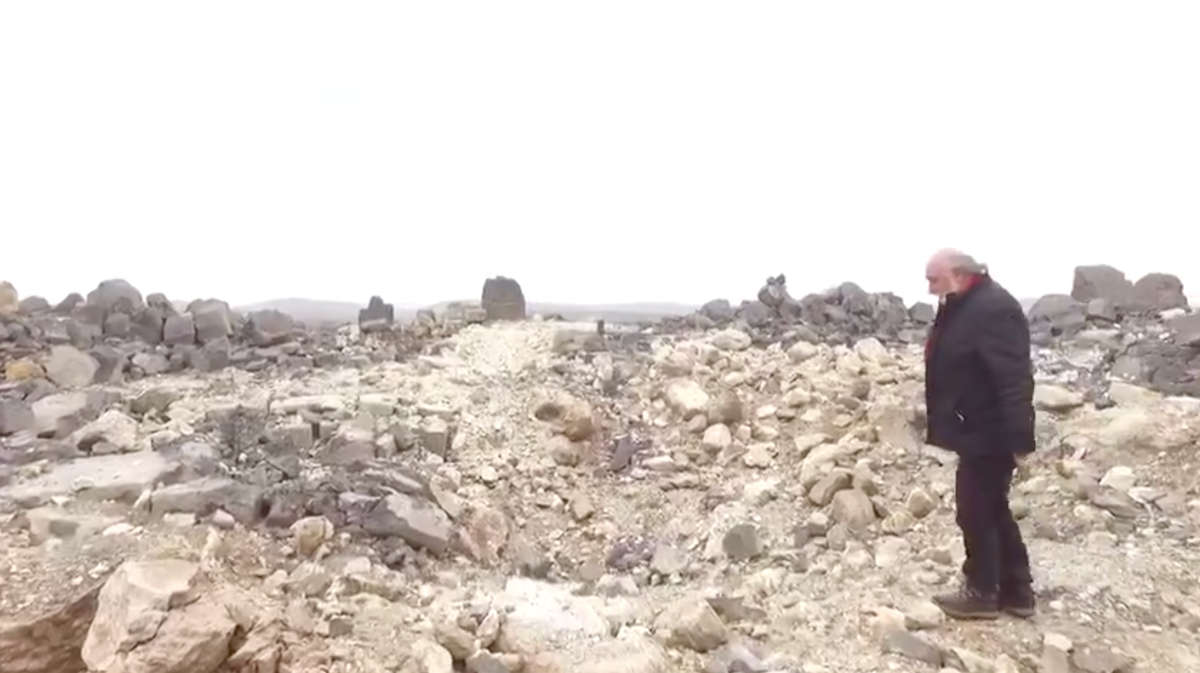
Video still of the crater in the entrance, seen from the southeast (Ghassan Shami; March 5, 2018)
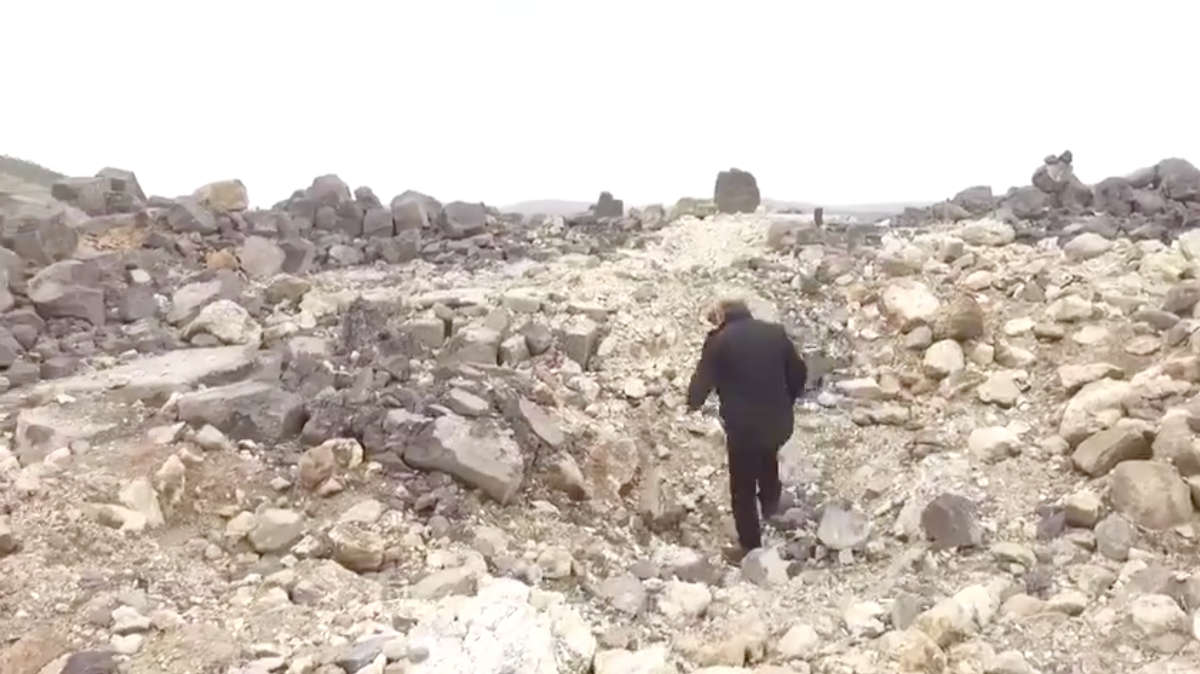
Video still of the crater in the entrance, seen from the southeast. Note the depth of the man in the crater relative to the original level of the pavement, which is visible on the left side of the image (Ghassan Shami; March 5, 2018)
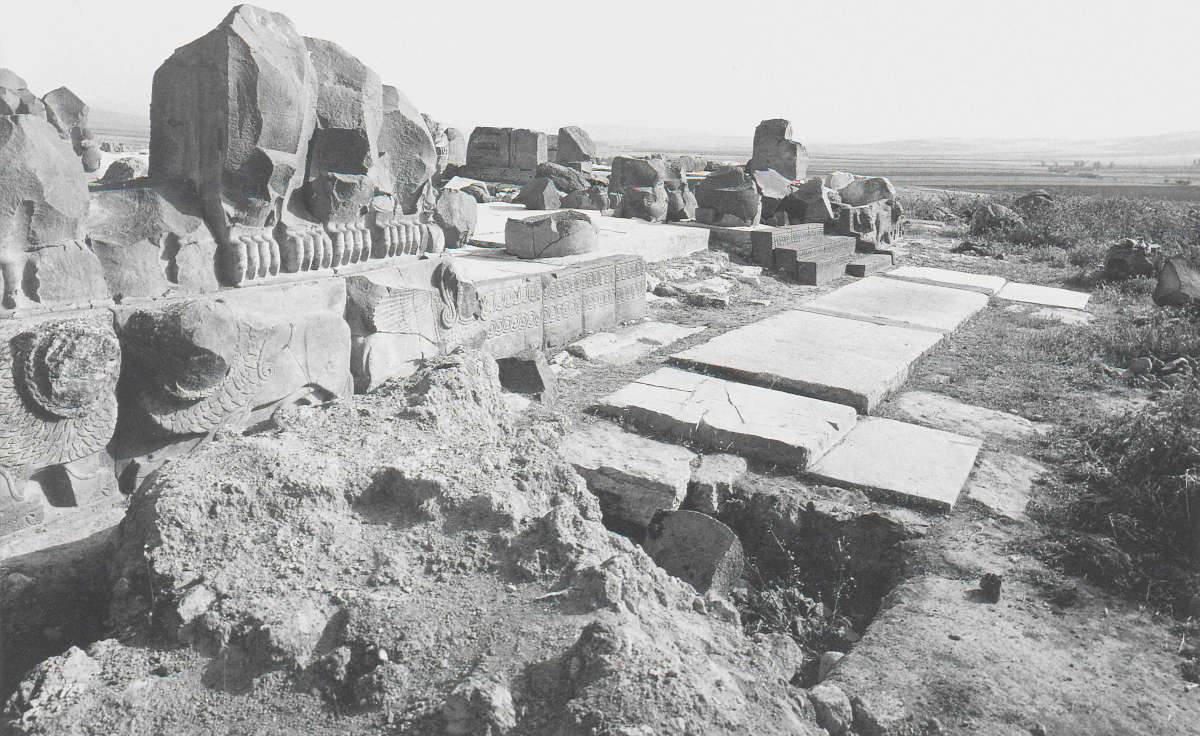
The entrance to the temple at the end of excavation, seen from the south (Assaf 1990: Taf. 8a)
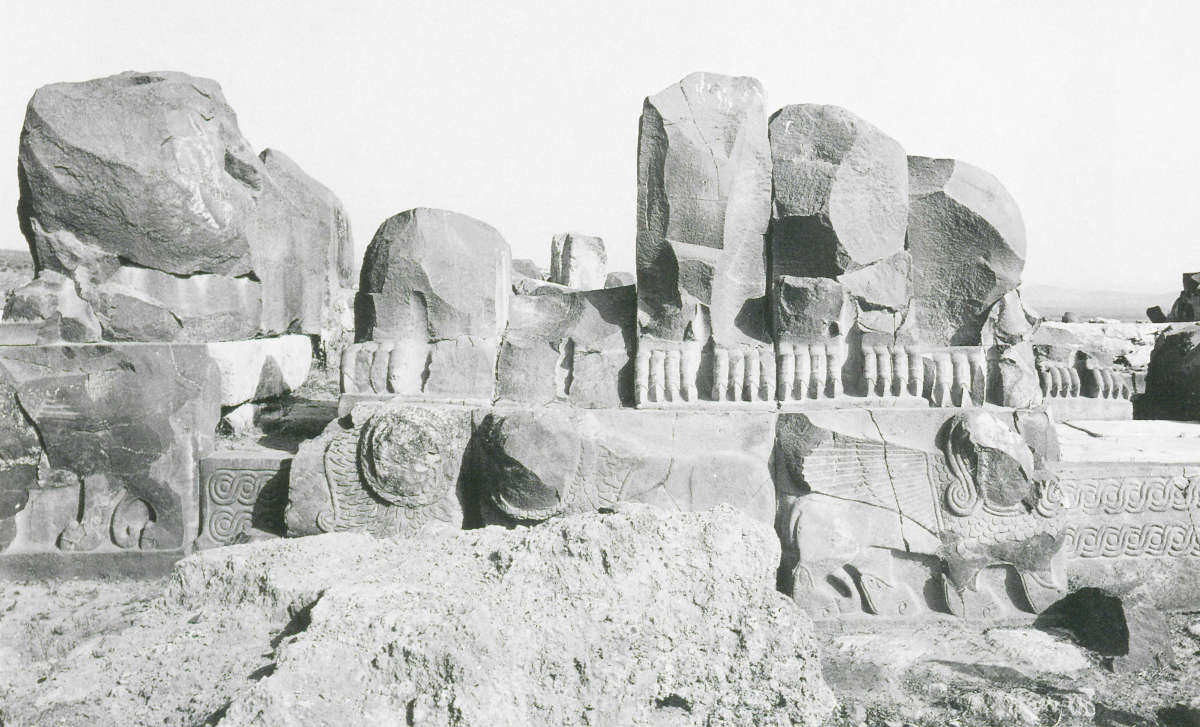
The facade west of the entrance at the end of excavation, seen from the southeast (Assaf 1990: Taf. 36b)
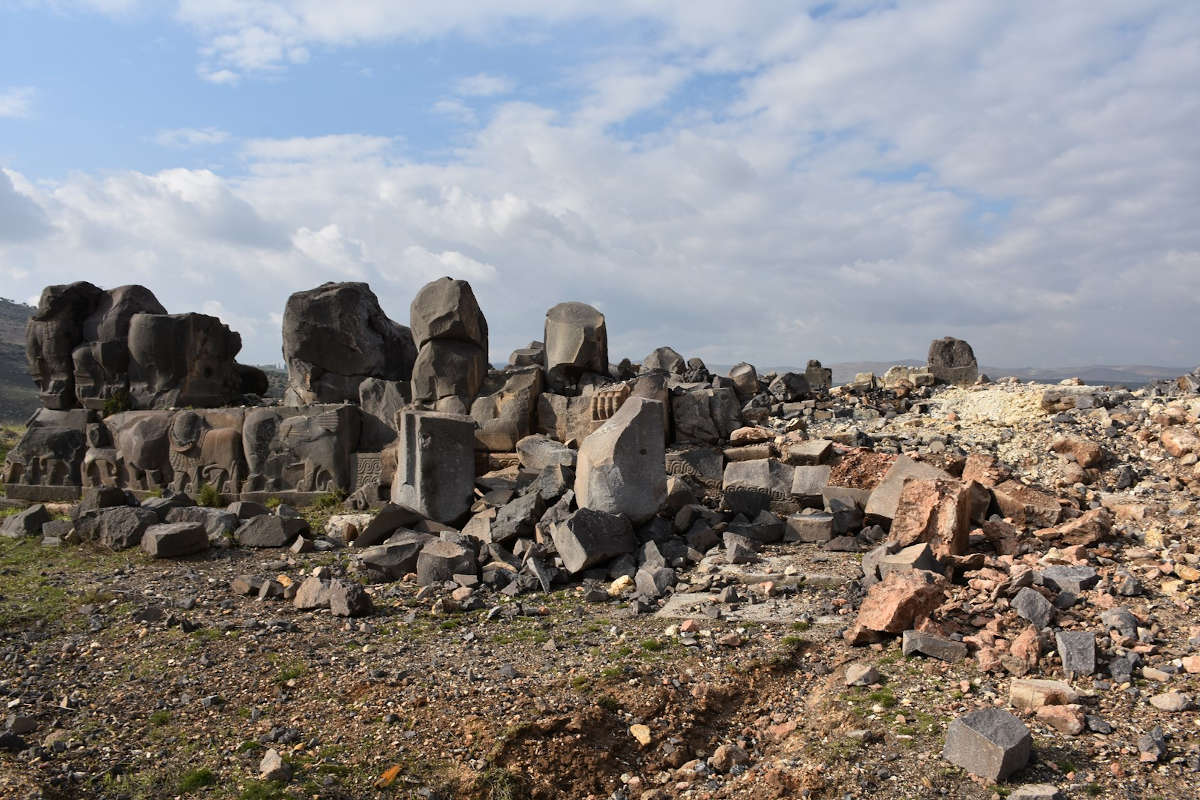
The western side of the entrance portico and temple facade after the attack (ANHA; January 27, 2018)
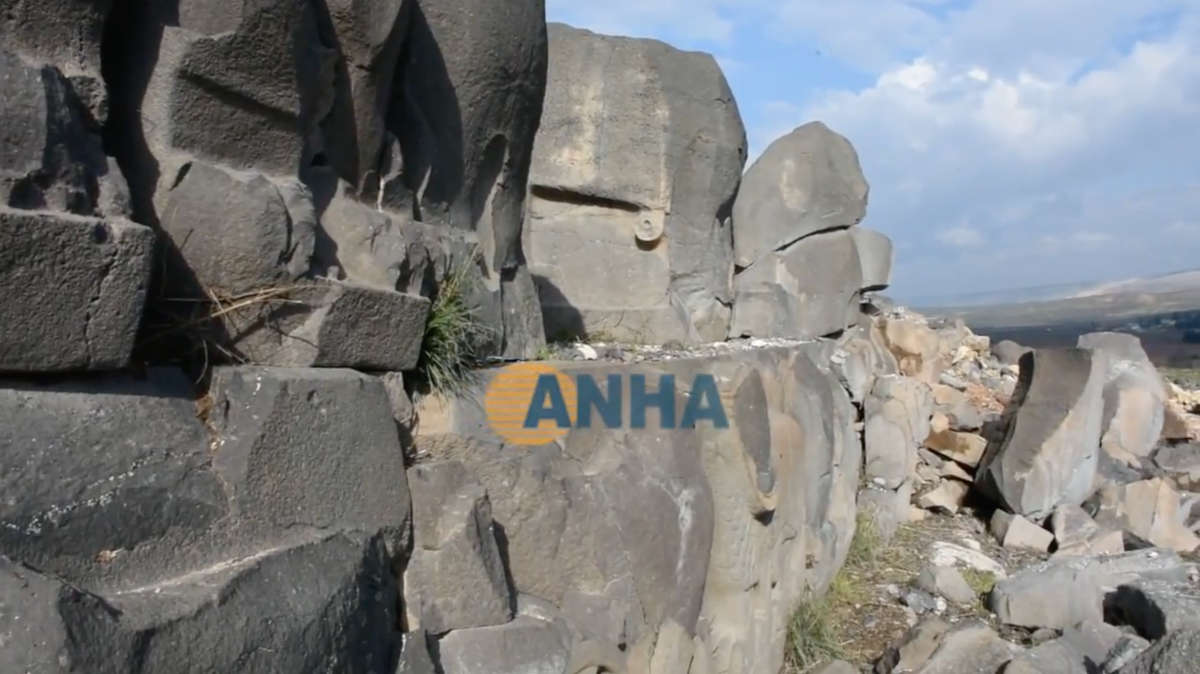
Video still of the facade west of the entrance after the attack, seen from the southwest (ANHA; January 27, 2018)
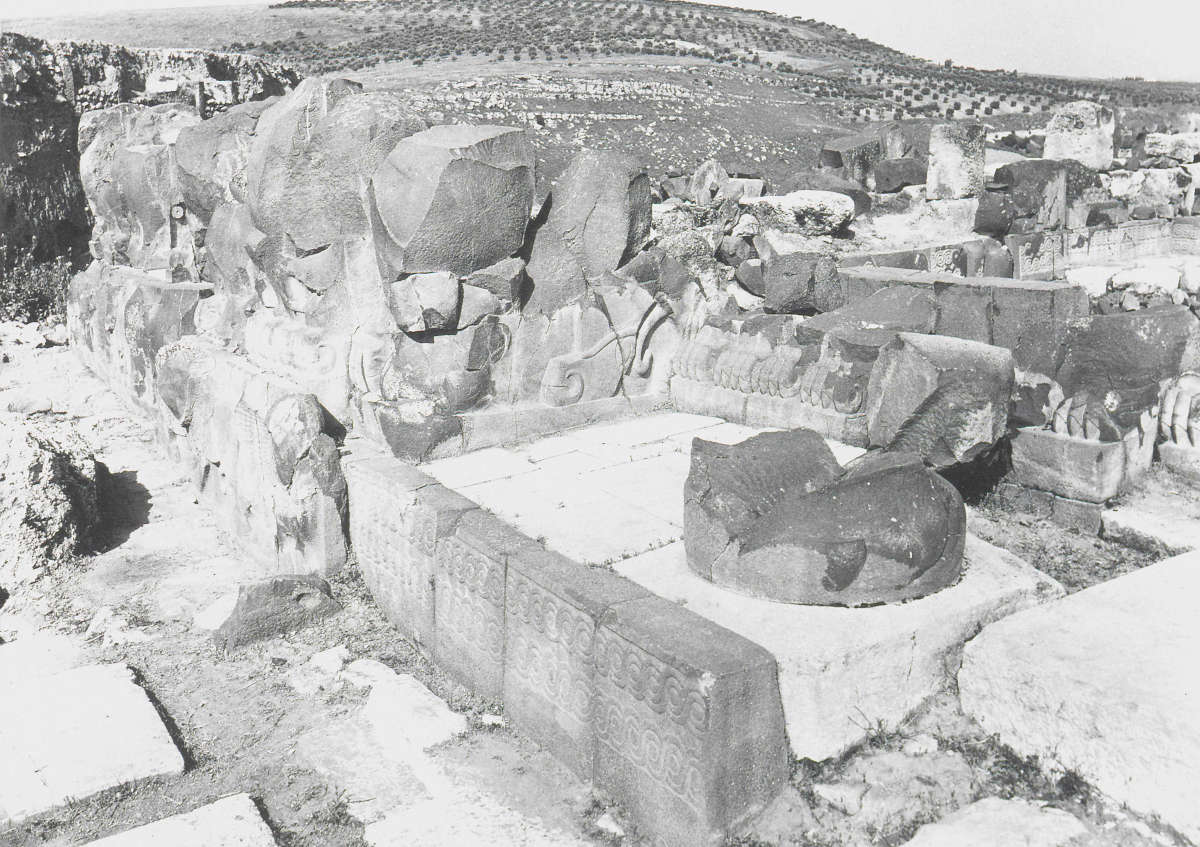
The western end of the entrance portico at the end of excavation, seen from the east (Assaf 1990: Taf. 9b)
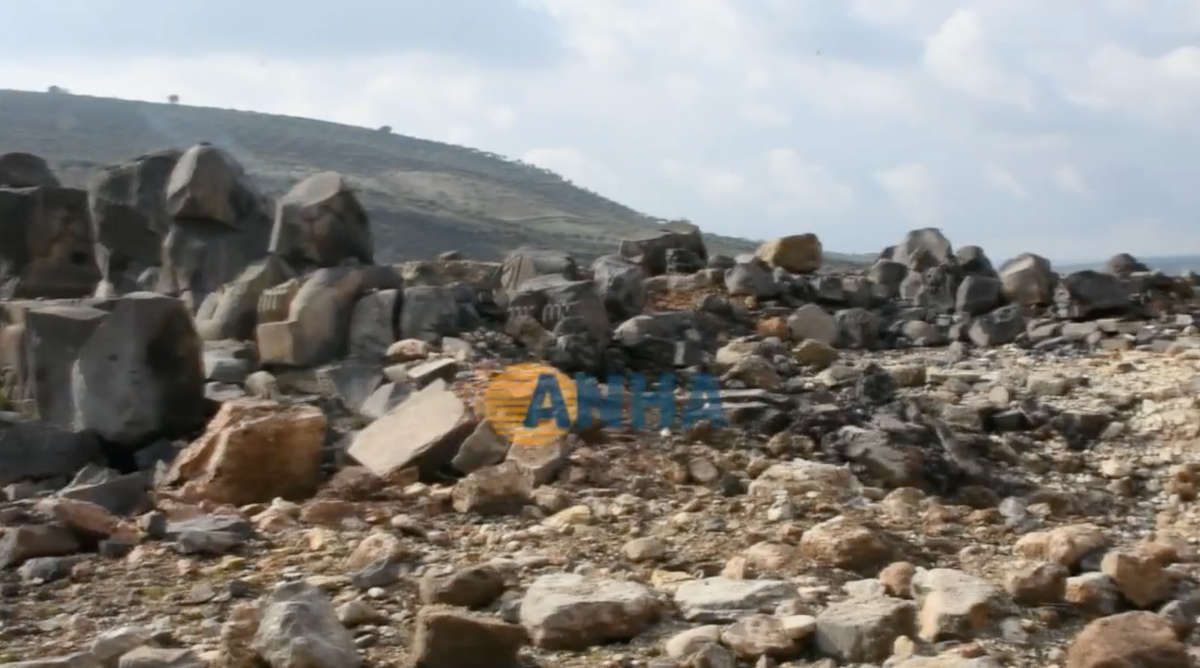
Video still of the western end of the entrance portico after the attack (ANHA; January 27, 2018)
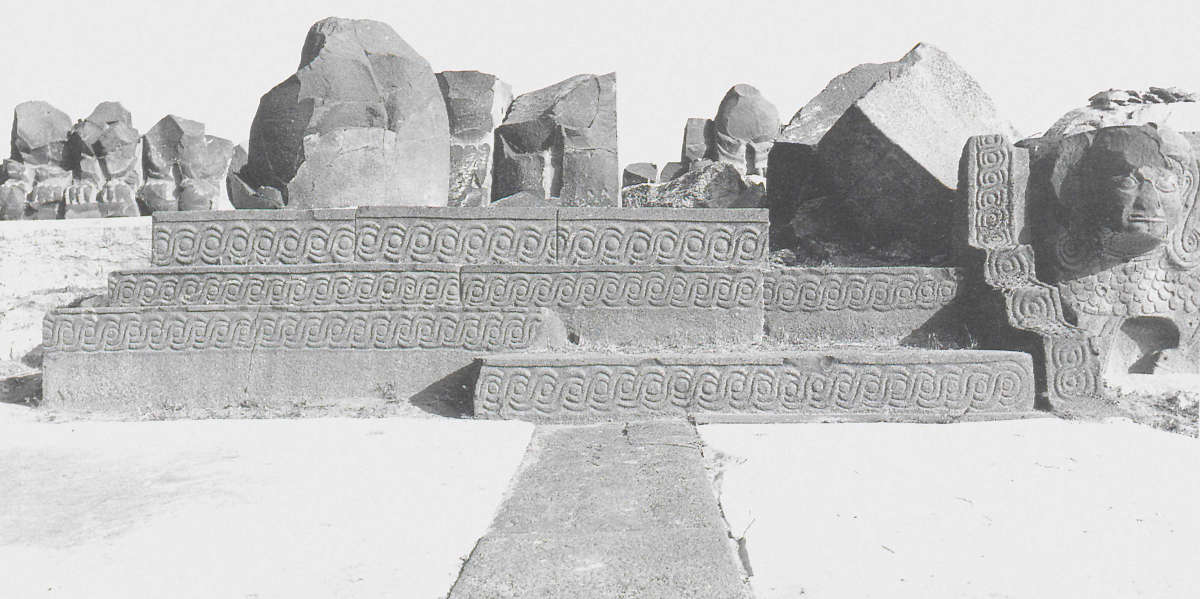
The stairs to the eastern end of the entrance portico at the end of excavation, seen from the southeast (Assaf 1990: Taf. 10b)
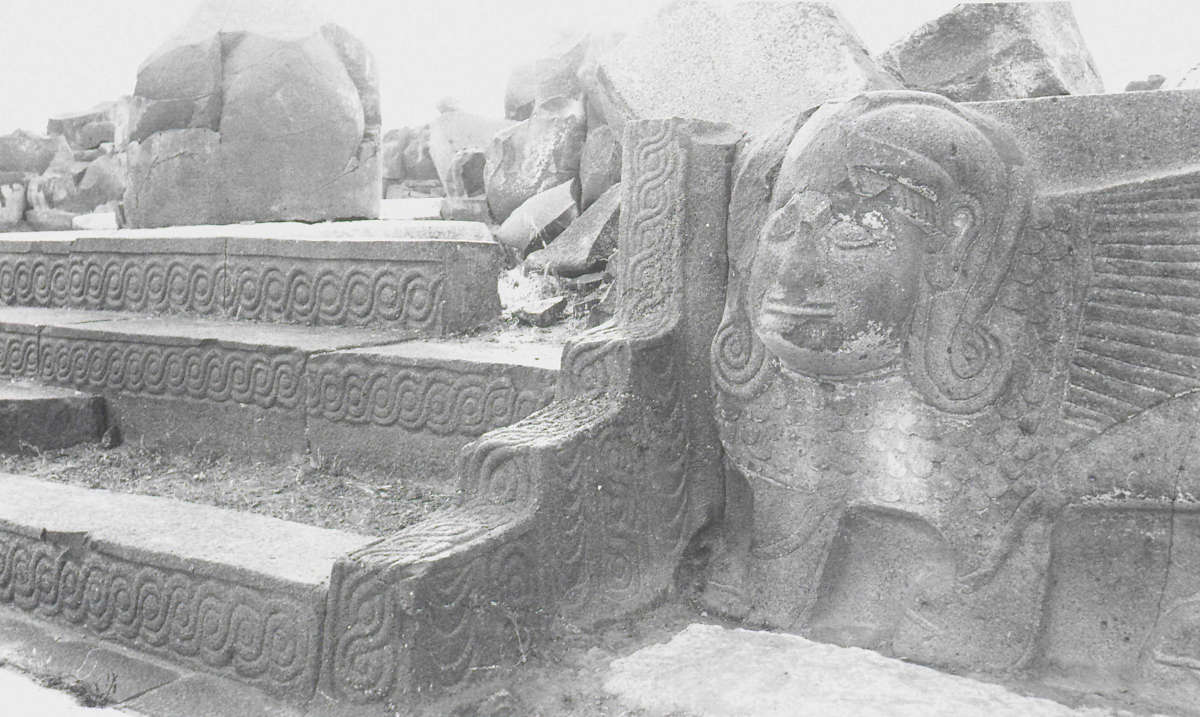
The stairs to the eastern end of the entrance portico at the end of excavation, seen from the east (Assaf 1990: Taf. 10c)
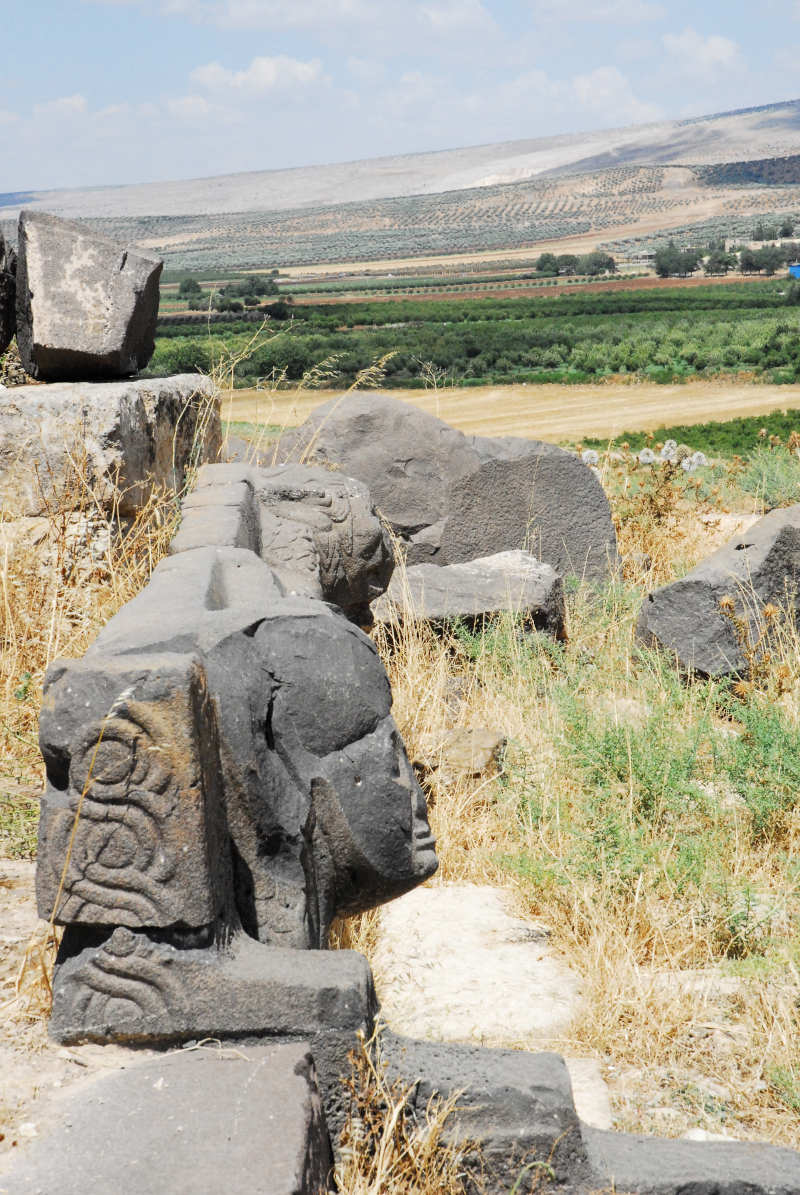
The temple facade east of the entrance in 2010, seen from the southwest (Michael Danti; June 2010)
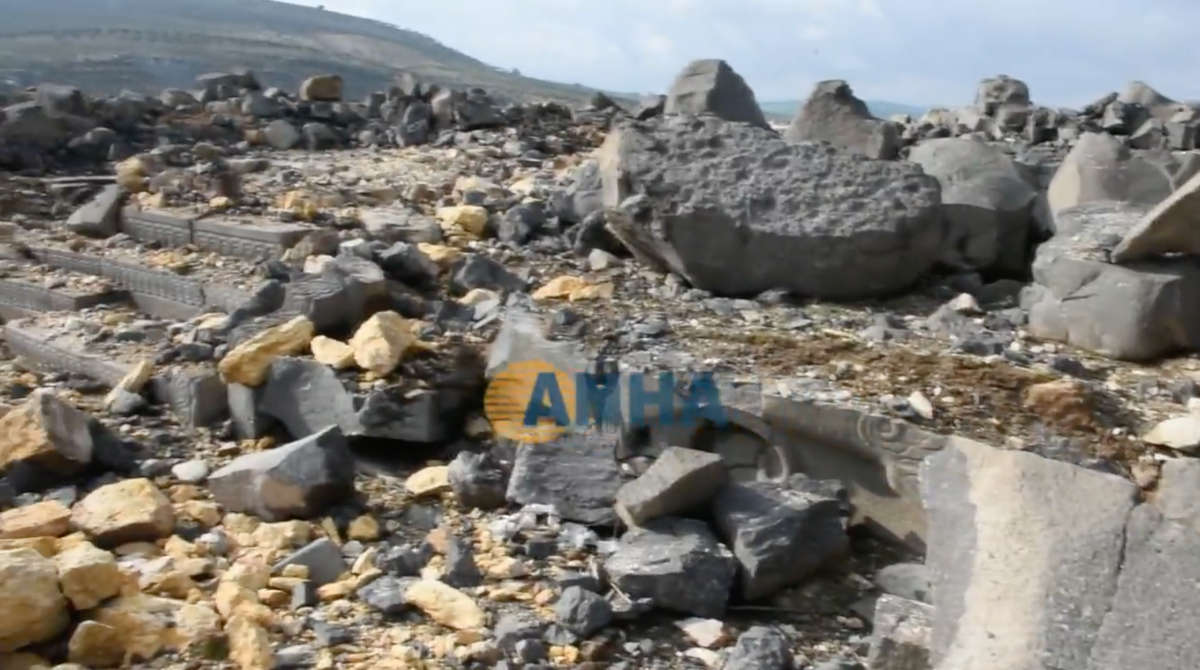
Video still of the temple facade east of the entrance after the attack, seen from the east (ANHA; January 27, 2018)
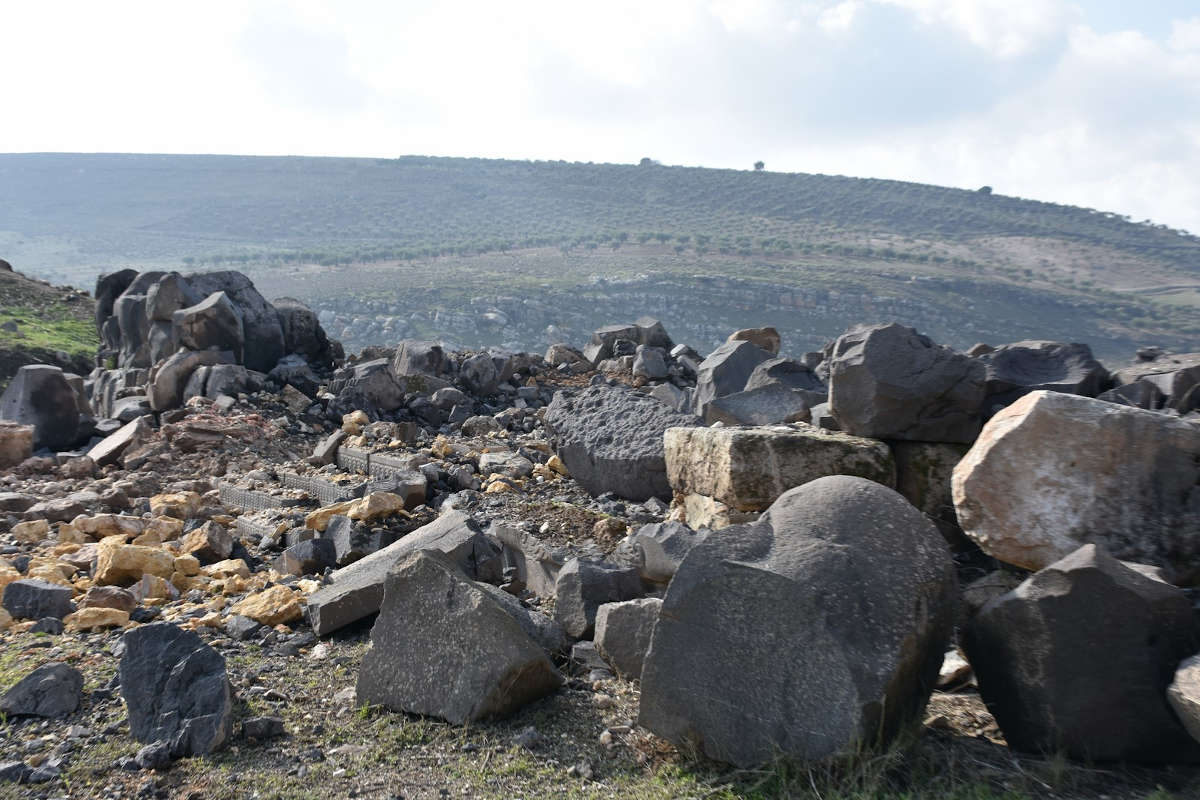
The temple facade east of the entrance after the attack, seen from the east (ANHA; January 27, 2018)
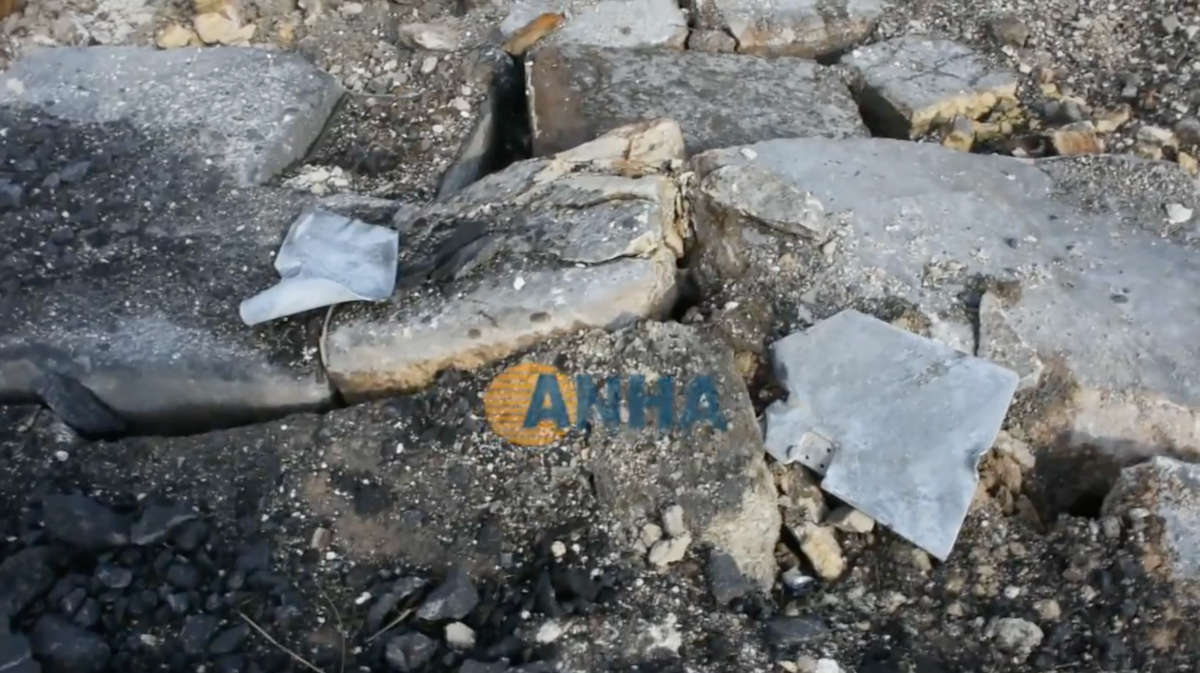
Video still of tail fins, probably from a JDAM, on the floor of the antecella (ANHA; January 27, 2018)
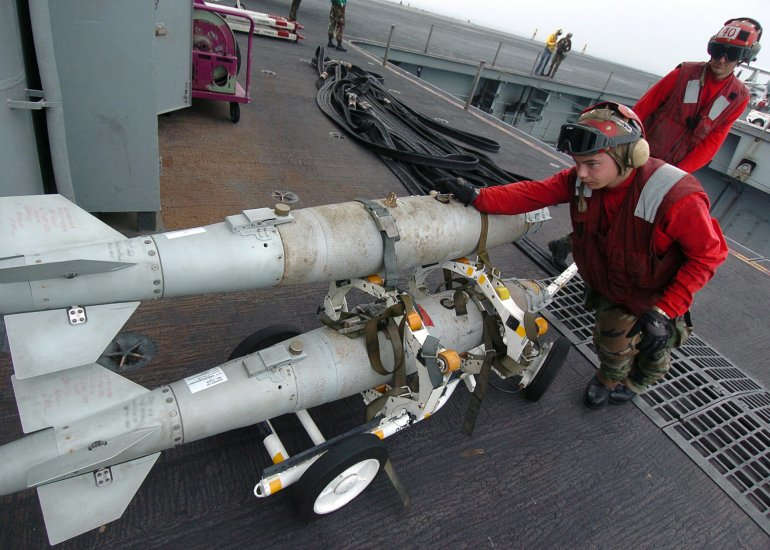
A GBU-38 JDAM (Global Security)
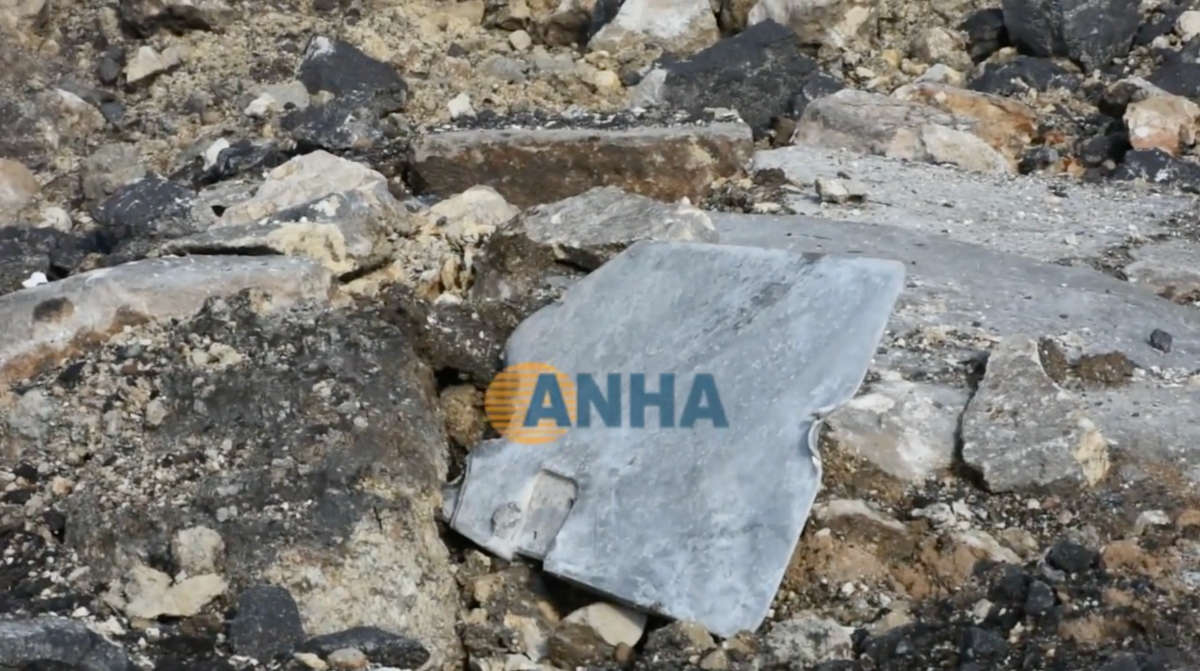
Video still of a tail fin, probably from a JDAM, on the floor of the antecella (ANHA; January 27, 2018)
